Spire by LazyAngel
Part 1
Original SA postI've been a lurker for several iterations of F&F, but haven't yet contributed anything, through a combination of crap writing skills and general laziness. However, there's a recently-kickstarted RPG that I backed that I figure needs all the exposure I can give it, so without further ado, I give you...
Spire part 1
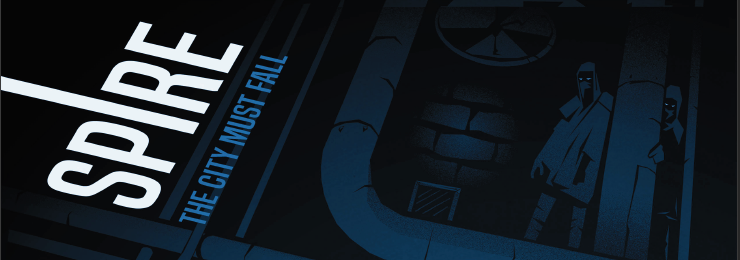
Spire is a fairly light RPG written by Grant Howitt and Chris Taylor, who together produce the Hearty Dice Friends podcast here in the UK. It's their first 'full' RPG, and they're mostly known for writing (very silly) one-page games (I think Honey Heist is the most well-known).
Anyway, Spire is a noir/punk urban fantasy RPG, where the players are a cell of Drow revolutionaries seeking to overthrow the cruel (or just indifferent, or incapable of empathy) Aelfir overlords who conquered the titular Spire (a city of mysterious and/or dubious origin built into a spire two miles high) from the original dark-elven house that ruled it. It's far from black and white; most Aelfir aren't arbitarily cruel, and the populace make do pretty well, whereas the Ministry of Our Hidden Mistress who send the players their marching orders is as likely to disavow or burn the characters if it suits their goals.
The Drow themselves are much as you'd expect; monochromatic skin, an adversion to the sun, a fungus-heavy diet and a thing for spiders. But the Drow of Spire are a gregarious, family-orientated people, and might well have been Aelfir in the first place, now labouring under a curse that drives them from the sun, whose light will blind drow eyes and blister their skin. They worship a triple goddess, the Danmou, and were the original (as far as anyone can tell) inhabitants of Spire. There are other Drow lands - the Homelands, but they're far away and wracked by civil war. Now the Drow of Spire must serve a Durance; four years of indentured labour, or be exiled from their home, and only the worship of Limye, Our Glorious Lady is permitted, with worship of the other two aspects of their traditional religion being forbidden.
The Aelfir are cold, both metaphorically and literally, coming as they do from the ice-bound lands to the far north (and tend to go a bit... strange if they spend too much time in the heat). They are graceful, magical, and quite possibly don't even have the capacity for empathy with lesser beings. They worship a Solar Pantheon; Father Summer, Brother Autumn, Mother Winter and Sister Spring, and always go about masked (showing your bare face in Aelfir society is possibly the most despicable breach of etiquette imaginable). They see Spire as their rightful conquest, and a valuable staging point in their wars with the Gnoll empires to the south.
Humans are the next most common inhabitants of the city, natural curiousity and cunning making them incorrigible tinkerers and engineers. Human scavengers rove through ancient arcologies of the long-dead Prokatakos civilisation for wierd and dangerous technologies and machinery. Their machines keep alot of Spire running, more or less.
As for the city itself, no-one really knows who built it, or where it came from. It's an irreguarly-shaped, two-mile-high block of ancient stone that could be a fossilised primordial creature, a Prokatakos machine-city, a larval god, or maybe just a really big building.
Next time: the rules and what you do with them
Part 2
Original SA post Spire part 2As was pointed out, the guys behind Spire did also come out with Unbound, which for some reason I thought had been covered in F&F. Maybe I'll get to it after Spire. Maybe pigs will sprout wings... who knows?

Welcome to Spire

So Spire is quite a focused RPG, as the characters will always be Drow revolutionaries, in service the Ministry of Our Hidden Mistress, a paramilitary cult worshipping a now-forbidden goddess of protection and vengeance. It's not glorious heroism, and they're probably not going to survive - even their families would probably turn them in to the City Guard, and the Ministry itself is a fickle and far from trustworthy master.
We kick off the text proper with the usual basics; die notations (this game uses D3 through D10), and the what-is-a-roleplaying-game bits (fairly short in this case). Then into what makes Spire different from run-of-the-mill fantasy;
Magic is hard it's not rare, but there's always a cost; divine, god-sanctioned magics exert the mind and soul (or even the purse), whereas riskier occult powers are even less reliable.
Magic items are rare usually re-worked, cobbled together fragments of ancient treasures.
We're not off to the wilderness. Spire is the setting, and unless something goes spectacuarly wrong, that's where the game will take place.
There's no morality system This isn't Good vs. Evil, and the players are going to be carrying out some very morally dubious acts in the pursuit of their goals.
There aren't any monsters With some caveats, everything they'll be going up against is, or was, a person.
The Rules
The basic mechanics of Spire will be familiar if you've read or played any of the *world games or hacks, as those are the main inspiration for a lot of the core design. When a character wants to do something, and there's something at stake, they roll a d10 against the following chart;
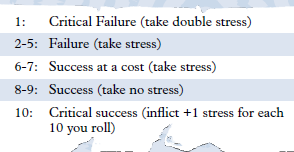
This looks a bit harsh, but if they've got a Skill they add a d10 to the roll and take the highest result. If they have a Domain relevant to the roll, they add another d10. Finally, if they have at least one Knack relevant to the situation, they add a further d10. Some situations or enemies will also have a Difficulty, usually from 0 to 2 - this is subtracted from the number of dice you roll, and if that number goes less than one, the extra points of difficulty shift the result of your roll down one level.
Stress is the consequence for failure (or partial success); either d3, d6 or d8 worth, depending on how critical or dangerous the situation is, and is applied to one of 5 tracks, or Resistances;
Blood stress is damage and fatigue
Mind stress covers insanity and mental instability
Silver stress hits characters' money and resources
Shadow stress increases the chance of their actions being revealed to their enemies or the authorities
Reputation stress is damage to your social standing
Every time stress is taken, the GM rolls a d10 against a character's total stress - if this is less than this amount, they take Fallout based on how much stress they've acumulated; this comes in Minor, Moderate and Severe flavours, and depends on the source of the latest stress hit (a variant rule is given if you want a less lethal game - treat each resistance seperately instead of using the total). There's a silver lining - taking Fallout does reduce your stress; more for more severe fallout.
Taking fallout when you've only got a bit of stress causes Minor fallout - things like Bleeding (Blood), being Shaken (Mind), Compromised (Shadow) or having to Pawn a piece of equipment (Silver). If you've got a bit more stress on you, then you'll be taking Moderate fallout - you could suffer from Memory Holes (Mind), have a Vendetta declared against you (Reputation) or get Arrested (Shadow). Finally Severe fallout usually results in permanent changes to a character, or spins off its own story arc; escaping death by being Chosen by a god (Blood), being Turned by the authorities (Silver or Shadow), or being Burned as a sacrifice by the Ministry (Shadow).
Fortunately, all the character classes provide additional resistance slots that aren't counted when rolling for fallout (and some equipment does the same - armour, for example, gives extra Blood slots) - this is the nearest thing this game has to conventional stats. In addition, a character can dump all their accumulated stress by laying low, keeping quiet, and letting the plot move ahead outside of their control. They can also remove stress narratively, by performing relevant actions (like buying the services of a back-alley surgeon to heal Blood stress), or by carrying out a Refresh action specific to their class (which has the added benefit of being able to remove stress from any resistence).
One point to note is that for all of this, only the players roll for actions, or to resist the actions of NPCs and the GM is only rolling for stress and fallour - indeed, the game suggests the GM keeps players stress totals hidden, although I'm not sure how practical this would be in play.
I think that's long enough for now. Next time I'll talk character creation.
Part 3
Original SA post Spire part 3We've gone through stress and resistances, now for the other parts of a character in Spire.

Skills and Domains
As mentioned in the rules explanation, characters have access to Skills and Domains which let them roll extra dice on tests. Both are simple; Skills relate to what you're doing, Domains to where you're doing it, or who you're doing it to, and they're binary; you have them or you don't - there's no levels of skill.
The Skills in spire are pretty self-explanatory; Compel (all forms of persuasion and intimidation), Deceive, Fight, Fix (machines, people, anything), Investigate, Pursue, Resist, Sneak and Steal. Domains cover the various parts of Spire's society; Academia, Crime, Commerce, High Society, Low Society, Occult, Order, Religion and Technology. Rolls get an extra d10 from having the relevant skill and/or domain - so if you're fighting a street gang down at the North Docks, the roll will be Fight + Crime or Fight + Commerce, depending on which domain you have.
Each additional time a character gets the same skill, they get a Knack, a specialisation in that skill that gives them mastery when the situation matches their specialisation (adding another d10 to the roll). Only one mastery can ever apply to a roll, so you're never going to be rolling more than 4d10, unless a class ability says otherwise.
Equipment
Spending money and resources in Spire is simply a case of taking Silver or Reputation stress, and equipment is handled in a very abstract way; when you acquire an item that matters to you, you define a positive aspect and a negative aspect for it. If you take advantage of the positive aspect, you get Mastery on a roll. If you have to rely on the negative aspect, the roll is made at +1 difficulty. Examples include;
- A beat-up old cart, with hidden containers for smuggling
- A strong parasol in gaudy unfasionable colours
- A bottle of moonshine that tastes beyond foul, but will polish metal to a mirror shine
Weapons and Armour
Weapons and armour are a bit more complicated; they're defined by how much stress they inflict or soak, and a set of *World-style tags. So a poisoned knife might be (D3, Ongoing D6, Concealable) - it does d3 stress when you succeed in a Fight action, then the target has to make a Resist check at the end of the scene or take another D6 stress (usually Blood). On the other hand, a human retro-engineerd galvanic arquebus (think steampunk lightning gun) would be (D8, Extreme Range, Dangerous, Unreliable) - it hits like a truck, can be used from a considerable distance away, breaks if you fail a roll with it for the scene, and finally explodes if your highest d10 is a 1 or 2.
Armour adds extra Blood resistance slots, and can help or hinder the character in other ways - a suit of Guard riot gear protects you very well, but it's Heavy, negating the use of Pursue or Sneak to give extra dice, whereas Iron spider-weave armour gives less resistance, but lets you camouflage yourself in amongst the pipes and foundries of The Works, in the bowels of Spire.
Bonds
Finally, all characters have Bonds - connections with other people, groups or organisations. They give two benefits; once per scene, if you act in a way that benefits one of your bonds, you can act with Mastery, and you can take stress to bonds to get them to do things for you, although you might have to ask nicely (or bribe, intimidate, etc). This acts the same as any other roll, getting an extra dice if it's something the target of the bond is good at, plus another if it's in on their home turf.
Like characters, Bonds can also take stress and fallout, which can result in damage to, or the severing of the character's relationships.
Bonds are defined by their scale - Individual, Street (a small to medium organisation) or City (a large organisation), and a given bond gets bonuses working on a scale smaller than itself - having the City Guard on your side against a street gang makes things a bit easier all round.
Next... character creation and classes - possibly some of the most interesting bits of the game
Part 4
Original SA post Spire part 4So, that's how to play, now for character creation!

Durance
So, the first step in creating a Spire character is to choose a Durance - the four year period of servitude they had to undergo in order to live and work in the city. It's also a common punishment for many crimes - it isn't precisely slavery, but it's not far off. Mechanically, a durance (or whatever your character did if they skipped it) gives a couple of bonuses - a skill, domain or +2 to a resistance - plus they kind of minor skills and knowledge they're likely to have picked up in their servitude. A few examples;
- Enlisted +2 Blood, Fight - you were part of the Allied Defense Force, off fighting the Gnolls (wrapped in scarves and robes to protect from the desert sun)
- Killer Sneak, Fight - you were an assassin in the service of an Aelfir noble, murdering their enemies in cold blood.
- Pet +2 Silver, High Society - you were too pretty to put to work, kept as a living objet d'art, and shown off at parties.
The book lists another dozen, plus ten more choices for drow who somehow avoided serving their durance.
Classes
So Spire is fundementally a class-based game, although they look rather like *World playbooks. A class grants a couple more bonuses to Skills, Domains and Resistances, a Refresh action (to get rid of stress), starting Bonds and Equipment and a list of Advances. These come in four flavours; Core - which every member of that class starts with, Low - a character starts with one of these, and will often earn another every other session or so. Medium Advances come from pulling off jobs and heists, and High Advances are only gained by making a significant change to Spire - whether good or bad.
Multiclassing is possible to an extent - you can exchange an Advance for one of a lower tier belonging to another class (if it makes sense). You can also spend a Low Advance on a new Skill, Domain or Knack, or for +1 to a resistance track. The rate of awarding Advances tends to determine the length of the campaign, and is up to negotiation with the GM.
Now for the classes themselves (and some of their more interesting advances);
Azurite
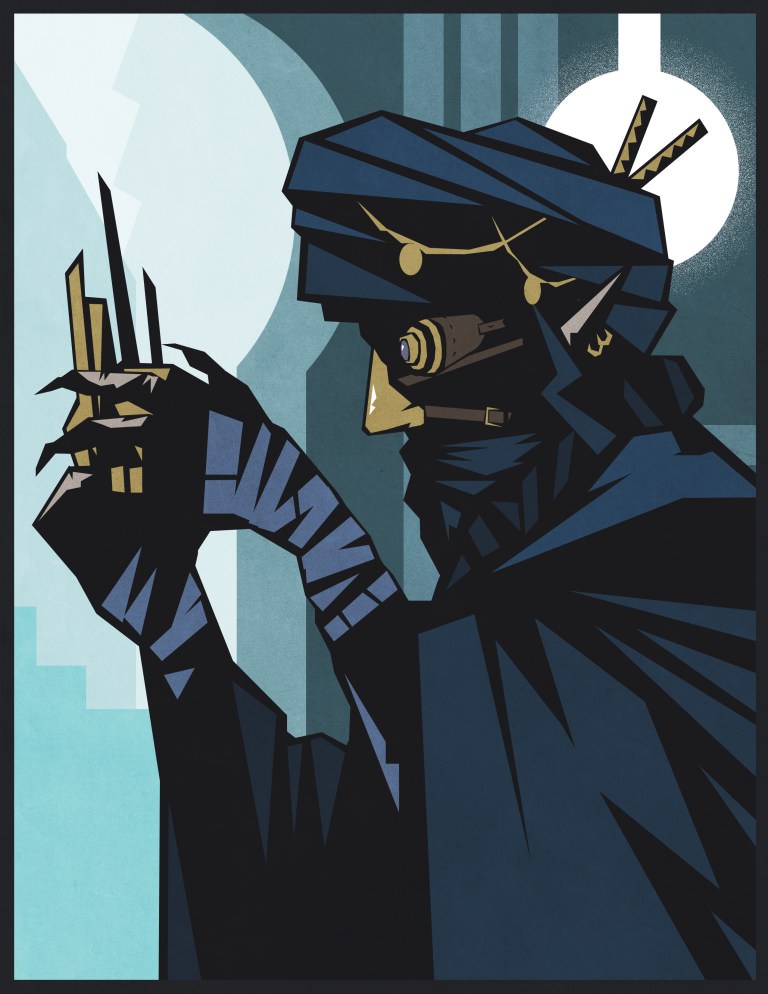
"Everyone has a price, Even you, my Lord"
Trader-priests of Azur, clothed in sacred blue and gold. Expert negotiators, they can buy or sell anything. They start with bonuses to Silver and Reputation, Compel and Deceive for skills and Commerce and either High or Low Society for domains. They can get rid of stress by carrying out a deal that benifits them more than the other part. Very much the social/knowledge character.
For starting Equipment, they either have a club-and-buckler combo with some basic blue robes, or more ornate clothing and a bodyguard (player chooses a name, description and two things they hate).
Advances
Core - once a session they can meet up with an NPC who can acquire anything they might need (but it won't be cheap), and once a scene they can pick an NPC; the GM then tells them what they want most of all at this moment.
Low. Azurites can buy knowledge, friends or languages; literally in this case, or curse a coin which inflicts magical greed on the holder.
Medium - Gaining armour whilst wearing the blue silks of the Azurite faithful, augmented versions of the Low advances, and buying the loyalty of entire organisations.
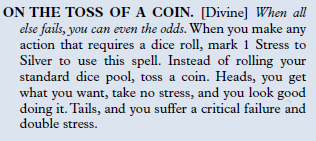
High - Buy literally anything - memory, skills, injuries, relationships as part of a willing contract. Buy a gift, and make the recipient treat you as a close personal friend.
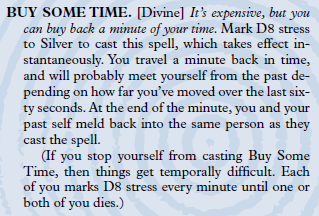
Next post, the Bound, the Carrion-Priest, the Firebrand
Part 5
Original SA post Spire part 5The next three classes... and another nine to go.

Bound
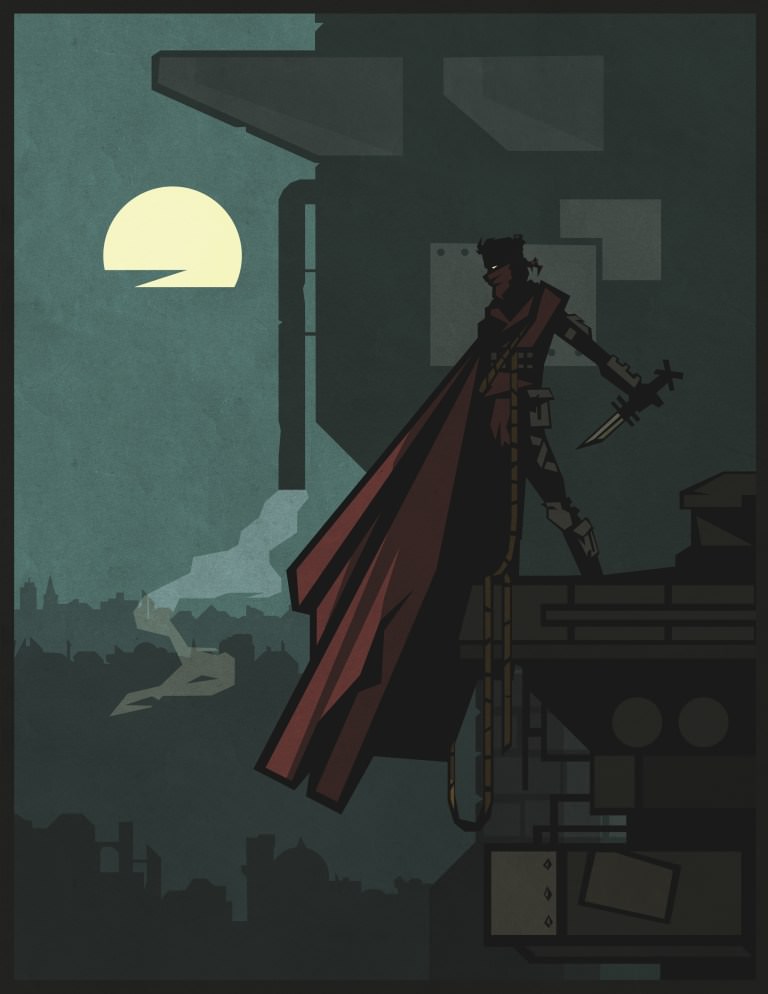
“Rope, secure me. Armour, shield me. Blade, bleed them dry.”
The Bound are vigilante-acrobats, worshipping and aided by the small gods bound into their armour, their ropes and their weapon. Coming from Perch, hanging off the side of the Spire, they are often the only source of justice for the common folk of that precarious district.
In game terms, they get bonus Blood and Shadow, and Refresh stress whenever they bring a criminal to justice. Very much a sneaky batman/assassin type, their advances revolve around gaining favour with the multitude of small gods bound into their gear - leather armour, ceremonial ropes and mask, climbing gear and a god-knife or god-axe (the knife is concealable, the axe hits harder, both are quite hungry).
Advances
Core Once a session, a Bound can insert themselves into a given situation where they're not present, as long as there's the faintest possibility of them being there. They also have the aforementioned Bound blade, used to channel their class abilities.
Low Augment the abilites of your armour, rope and blade, and cause fear in your enemies, and hide in any crowd.
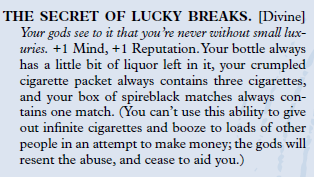
Medium Teach your blade to drink the Blood of your enemies. Swap places with an ally wearing a mask. Use your rope as an animate weapon.
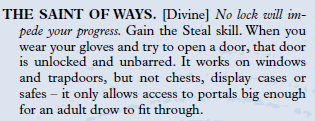
High Wounding a mortal will kill them. You're hidden from light itself. You can walk on any solid surface is if it was horizontal ground.
Carrion Priest
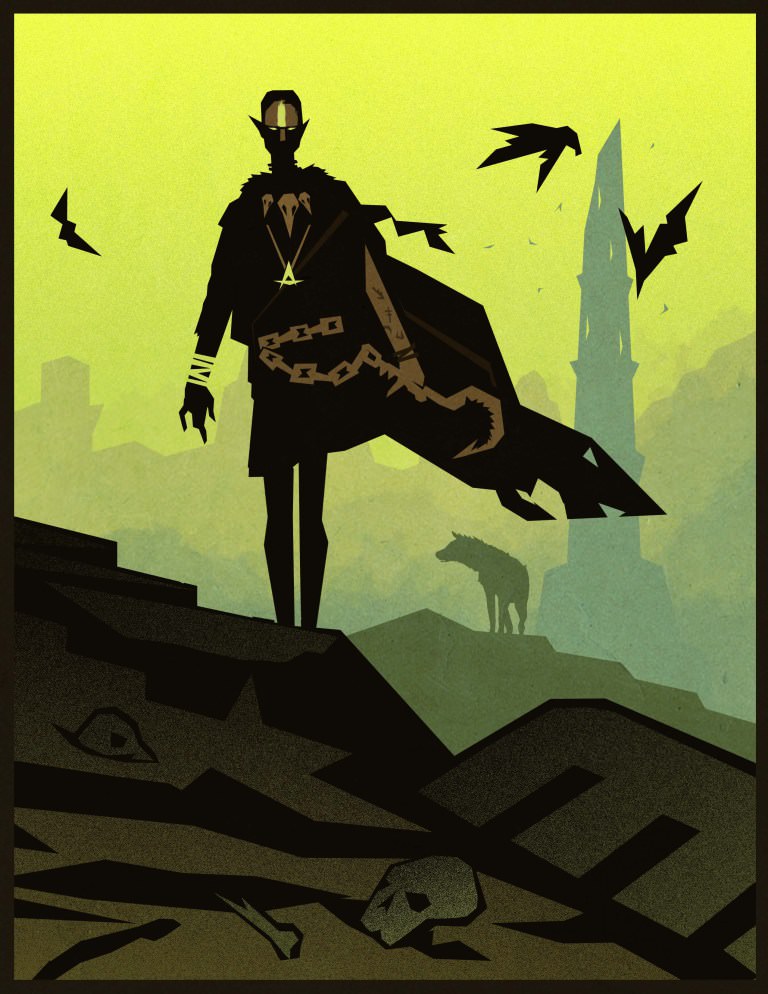
“Charnel feasts tonight, brothers! As do we.”
Priests of a the Gnoll Hyena-god of Death, followers of Charnel are an alternative to the orthodox Morticians of the Spire, believing that to reach the afterlife bodies should be consumed by the sacred hyenas of their god.
They are hunters and necromancers, with a bonded hyena companion, which lets them get extra tags in combat depending on the orders it's given. They've got bonuses to Blood and Reputation (they may be weird death worshippers, but they're pretty useful), and refresh stress whenever they complete a hunt and take their prey.
Advances
Core The hyena I mentioned before. In addition, whenever they enter a dangerous situation, their player can name three features or opportunities that their allies can take advantage of.
Low Further train your hyena. Mark a target as prey for you and your allies. Summon a murder of crows as a distraction.
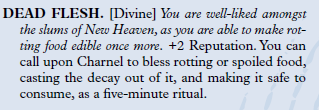
Medium Talk to and physically interact with ghosts. Remove stress through cannibalism. Santify your weapon to Charnel, spreading damage around your enemies. Turn into a (larger than normal) crow until sunrise, or someone speaks your full name within earshot.
High Mark a target and you can step out of the shadows near them whenever you want. Summon a literal murder of crows. Merge with your hyena as a divine monstrosity.
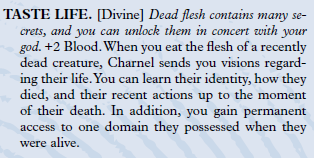
Firebrand
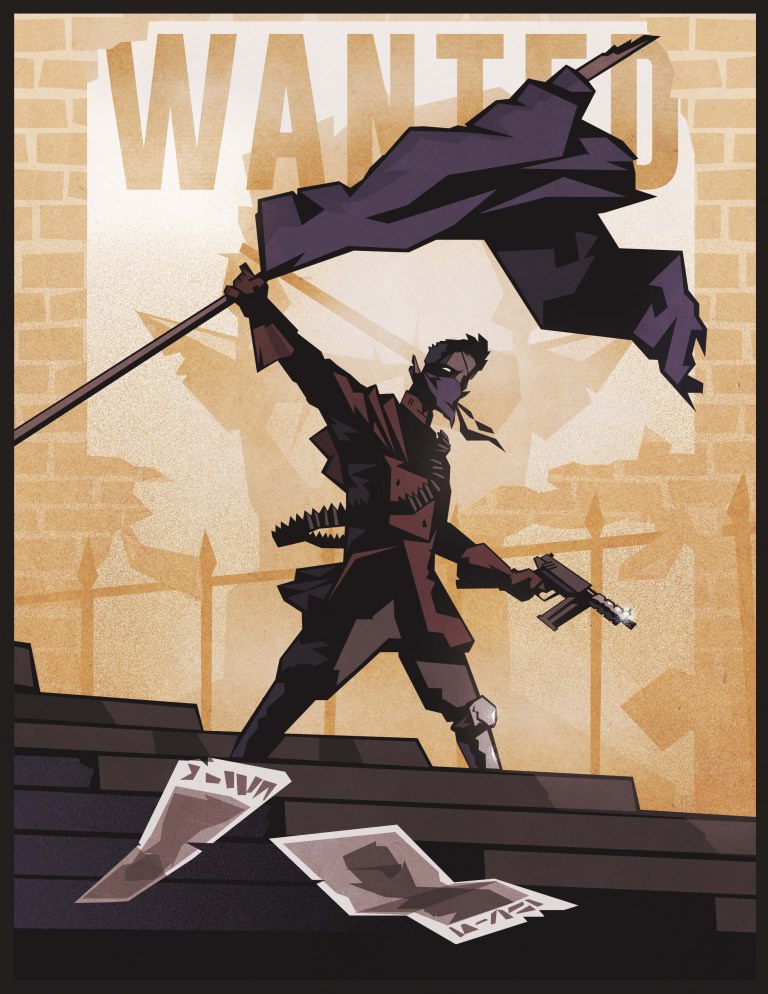
“They can’t take us all on. Not all of us. Tonight, we show them who’s really
in charge.”
Not just a Minister of Our Hidden Mistress, but a true revolutionary, wielding the torch, the crowd and the barricade in pursuit of an ideal, and willing to pay the price.
High Reputation, and some Shadow resistance, they Refresh whenever they take something back from an oppressor. They work the crowd, and their abilities revolve around sacrifice and being the underdog. They also end up nearly impossible to kill.
Advances
Core Get Mastery on all actions when you've got high Shadow stress. Once per session draw a crowd to you in a matter of minutes.
Low Rile up the crowd. Bluff your way situations through sheer charisma and bravado. Gain the favour of Limye, Our Glorious Lady (i.e. take an advance from the Lajhan, the priests of the moon).
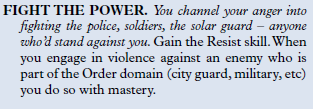
Medium Cause a riot when you need one, and attract a cadre of revolutionaries. Shift blame, terrify enemies, have allies take fallout for you (willingly or not).
High Turn any improvised item into a (frankly terrifying) weapon. Take any stress to Mind instead. Survive as the idea of revolution, reforming a week or so later.
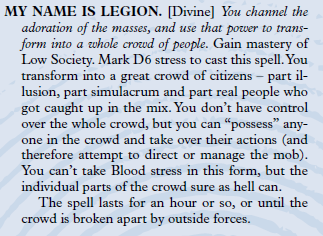
Next: the Idol, the Knight, the Lahjan
Part 6
Original SA post Spire part 6
Idol
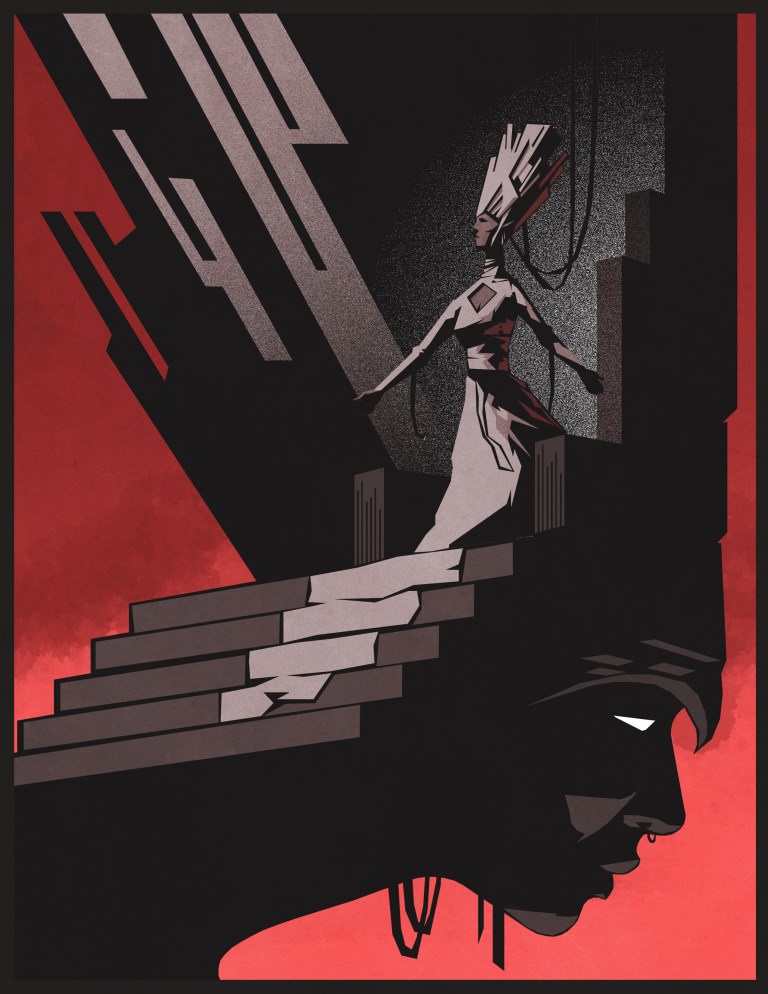
“Truth? What is truth, when you have beauty?”
The Idol is the consummate artist, wielding charm, poise and back-alley sorcery in equal measure. They are social butterflies par excellance, and surprisingly hard to harm, as even bullets fail to mar their beauty.
They have a spread of resistances; Reputation and a bit in Silver and Mind, and refresh when their art (and this can be any art) deeply moves an audience. They're not particuarly well-equipped; cloths, tools or instruments and a hidden knife, but really, violence is what devotees are for...
Advances
Core Once a session, create an instant gathering or party, giving you master to persuade, deceive or distract within it. Once a scene, change your appearence to represent an NPC's ideal partner.
Low Become too perfect to fail. Influence someone who doesn't yet know your name. Be too beautiful for people to harm. Drive a crowd into extremes of emotion.
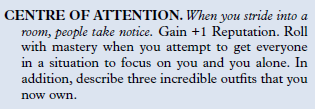
Medium Gain actual physical armour through being too pretty to hurt. Force a foe to harm themselves through sheer humiliation. Push an NPC you have a bond with into any action, no matter how depraved. Implant a subcoscious suggestion into your art.
High Claim any individual who sees you as a temporary (then permanent) Bond. Create the picture/novel/opera/morris dance of Dorian Grey, becoming immune to age as long as you don't experience your artwork (it has to be displayed/performed however). Just become too perfect for misfortune to befall you.
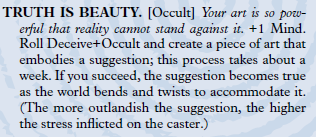
Knight
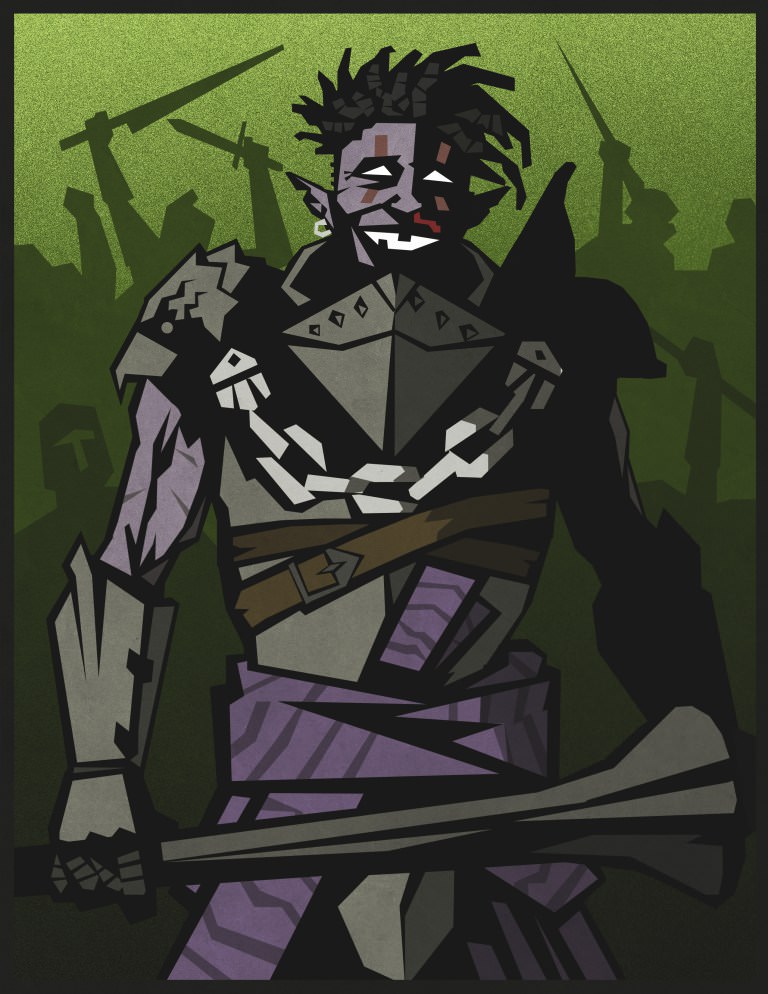
“I swear to Our Lady, this hangover could bring down a skywhale. Did we win?”
Possible the Best Class (although I quite like the Bound). Centuries ago, the knightly Order of St. Beneferas were granted the right to police the northern (river) docks of Spire. Generations of factional rivalry and petty squabbling have left them little more than street gangs with a tendency towards alarming displays of violence, operating out of the many inns and pubs that litter the docks.
Surprisingly, their best resistance (such that it is) is Silver - protection rackets and intimidation pay well, as well as bonuses to Blood and Reputation. They also get heavy armour, and a variety of large bladed weapons; which they expressedly have the legal right to carry. They're drinkers and brawlers without peer, and are surprisingly good at knowing when and where to do both. They refresh, unsurprisingly by engaging in reckless excess.
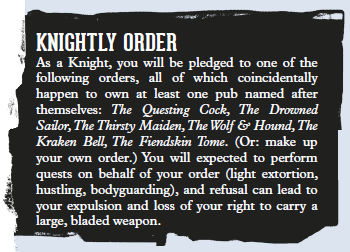
Advances
Core Once per game, name a nearby pub, bar or inn where you know the landlord. Once a scene the GM tells you who the best person to pick a fight with is, depending on whether you want to win, make a good impression or just cause a distraction.
Low Make bonds by getting drunk with someone. Convince an NPC that you can acheieve some deed. Take greater advantage of your armour in combat. Fight better with a crowd watching.
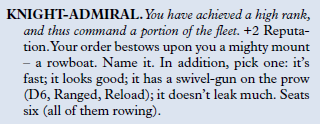
Medium Make bonds by getting drunk with someone and their mates. Fight better whilst outnumbered. Gain the power of arrest.
High All High advances revolve around going on a semi-mystical quest, mostly involving a pub. Forge a renowed suit of armour. Pull the sword from the stone (a pub). Seek the Grail (a legendary pub housing the now-immortal founder of your order).
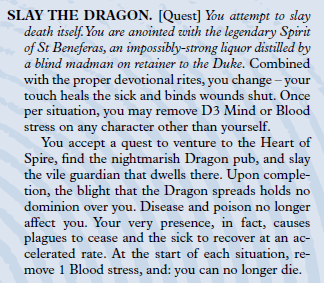
Lahjan
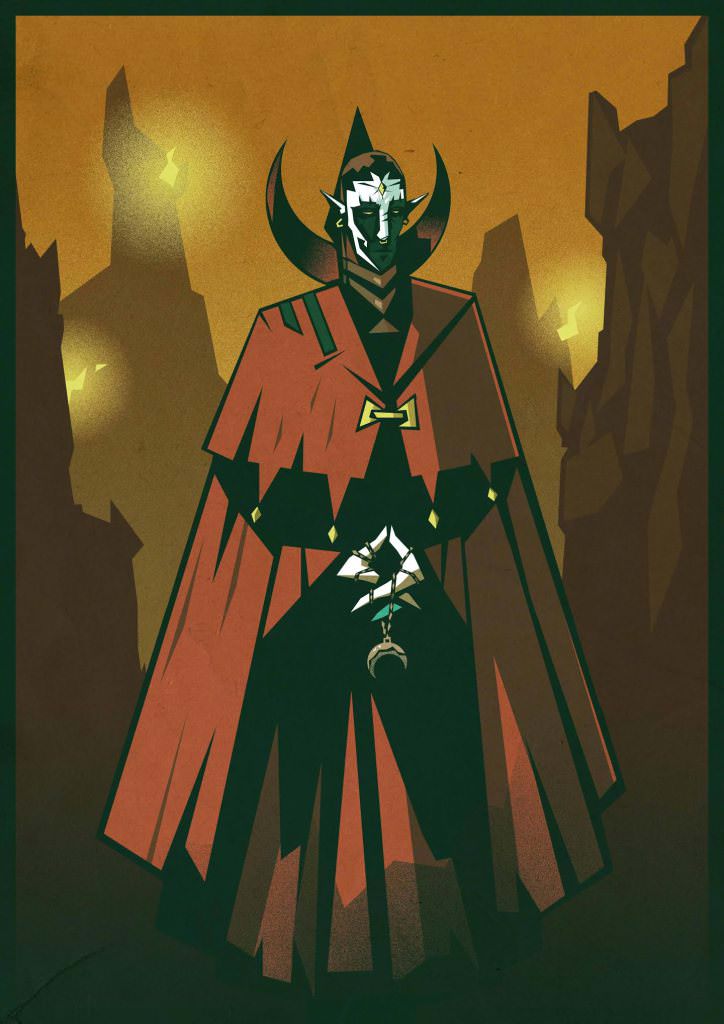
“Our Lady protects, sweetness. Hold her in your heart and she will soothe your passing.”
The Danmou, the traditional Drow goddesses are three in number. Of them, the only one premitted worship by the Aelfir is Limye; Our Glorious Lady, who is the light side of the moon, shedding radiance that doesn't burn drow skin like the sun does. The Lahjan, or 'silvered' are her chosen priests, tasked with providing aid and succor to the needy. They can be sneaky buggers too.
Big resistance gains to both Mind and Reputation, and they refresh stress whenever the help those who cannot help themselves. Their advances have an emphasis on healing and avoiding difficulty, with a possible side-track into becoming a blind oracle.
Advances
Core Once a session, lead a rite of recuperative meditation, helping your allies shed stress. Cast forth moonlight at will.
Low Take stress from youe allies, or push them into riskier actions. Find those in need of help. Ward an area from unwanted intruders. Prevent violent actions from thse around you.
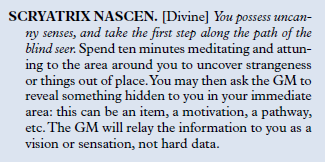
Medium Become a true seer, seeing the true nature of those around you at the cost of physical sight (although at this stage this involves a blindfold). Hide your allies behind mirage and illusion or share stress with them. Wield moonlight as a weapon.
High Become a patch of moonlight. Prevent any fallout from affecting your allies until the end of the scene. Blind yourself with silver needles to see auras permanently - see connections with items, emotions, relationships. And get the ability to sever them.
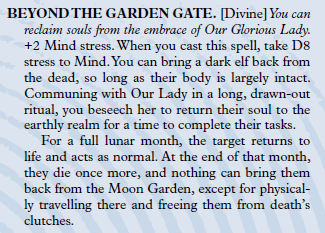
Various saints have additional advances associated with them - I'll cover those when I do the minor paths later.
Next: the Masked, the Midwife and the Vermissian Sage; the last three core classes.
Part 7
Original SA post Spire part 7So there's one supplement out for Spire - Black Magic - which has an 11th class in it. I figured for clarity, why not treat you to it sooner rather than later...
(Apologies if I get a tad florid; bit under the weather)

Masked
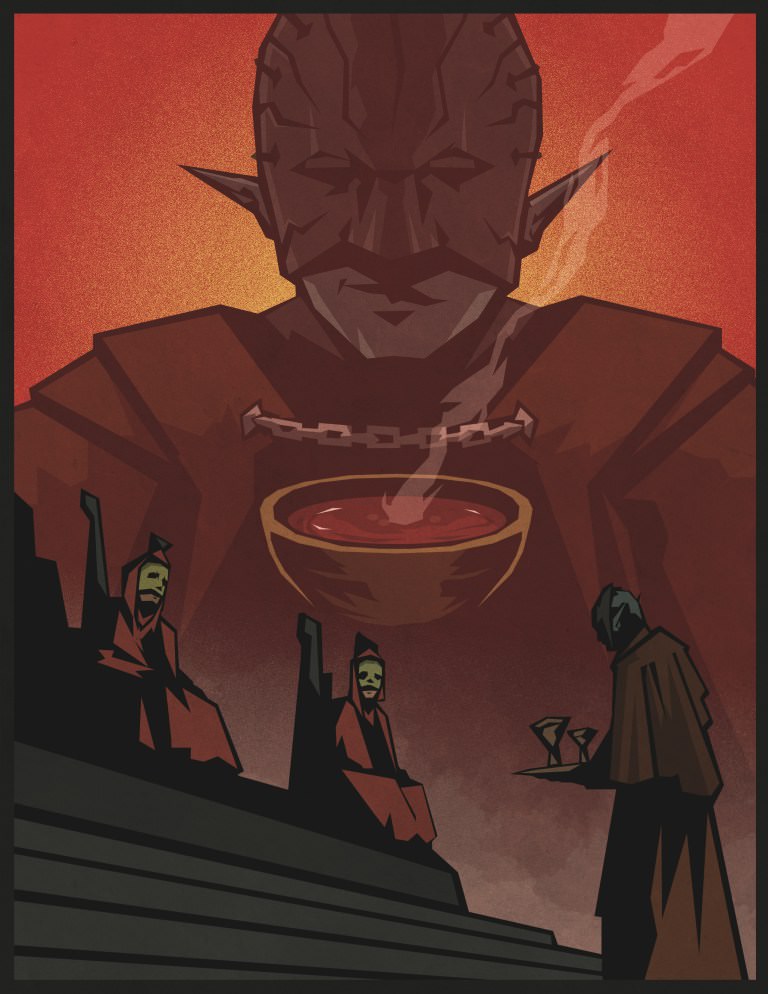
“Ah, my Lord, my apologies – these are the correct manifests, not the ones you have there. I’ve had the delivery boy shot already to anticipate your desires.”
From the Aelfir point of view, the Drow are in the Spire purely to serve, and the Masked have indeed done so. Manservants, maids and butlers, they are masters of not being seen, concealed behinds masks and the anonymity of their station.
A mix of resistances, and they Refresh when they show someone they shouldn't have underestimated them. They're very social, especially when it comes to navigating the upper echelons of society, and those who serve them. Many of their abilities revolve around wearing one of a number of masks.
Advances
Core Once a session, the GM tells you who's really in charge there. You also get mastery when interacting with the Aelfir.
Low Wear a mask to pass as someone beneath the notice of your target, or one to deflect Mind stress and fallout. Blend into household staff or employees of an organisation. Never get surprised or lose track of your surroundings. Buff an ally's social skills through advice and carefully selected clothing choices.
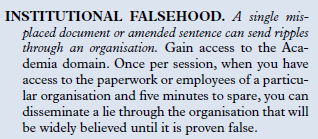
Medium Wear a mask to make an NPC fall for you, or one that lets you appear as someone rich and famous. Or wear the Mouthless Mask to silence the actions taken by you or those around you.
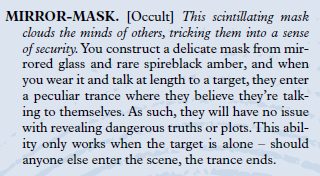
High Wear the Masterless Mask to strike back against the Aelfir and thrive on the worship of the downtrodden. Craft a mask that lets you control the body of the wearer. Weave a mask that lets you perfectly impersonate another. Craft a mask to trick the gods into granting you power.
Midwife
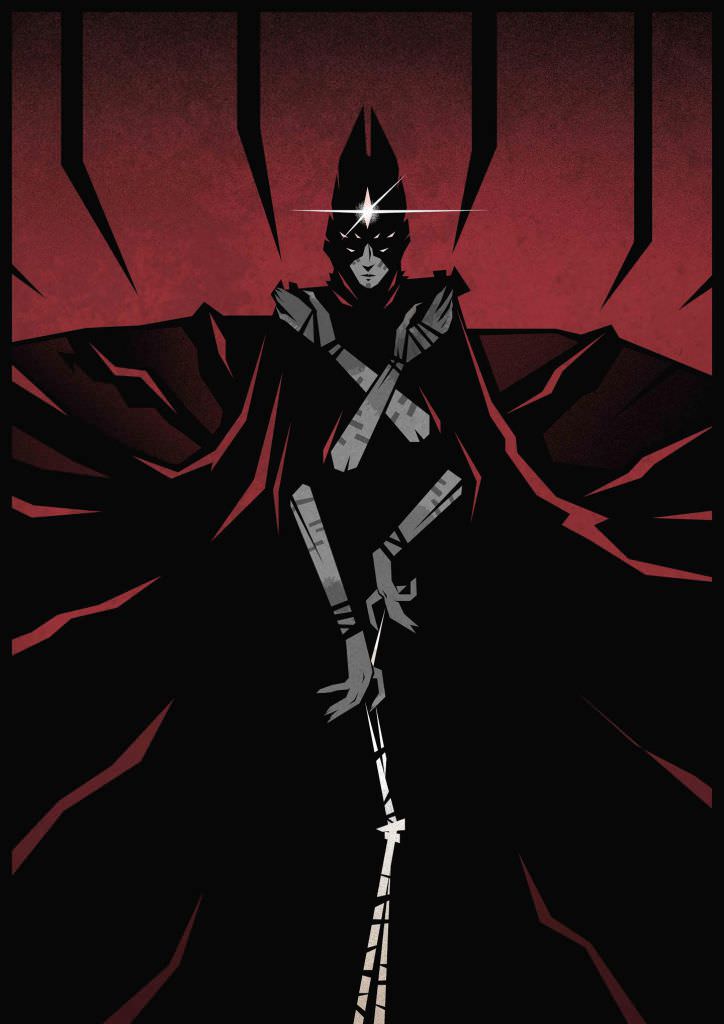
“Of course I will fight for you; the web connects us all, brother.”
The Drow are a cursed people. Unable to bear the touch of the sun, and even their children are born from fragile, vulnerable eggs, which must be carefully tending with blood donated by their parents (and others). Fortunately, an early pact with the spider-goddess Ishkrah resulted in the order of Midwives, holy protectors of drow families and children yet unborn. Who can become fuck-off enormous spiders, so there's that as well.
Focused on Blood resistance, with good Reputation and Mind, they Refresh stress whenever they defend those who cannot defend themselves. Oddly-enough, they're pretty much classical paladins in practive, concentrating on defending and aiding others.
Advances
Core Take stress to prevent fallout affecting an ally. Once per session, determine what it is a given NPC wants to protect above all else.
Low Heal yourself or others. Ward an area with occult webs. Grow chitenous claws or additional eyes which can see magical energies. Force enemies to act upon each other. Decant your madness into ink-black liquid, healing Mind stress.
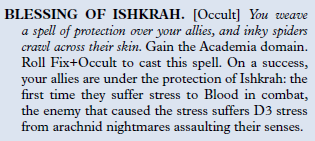
Medium Harden you skin into a shell. Grow venemous mandibles to inject or spit poison. Sprout additional legs and walk on any grippable surface. Summon swarms of spiders to watch over and protect you.
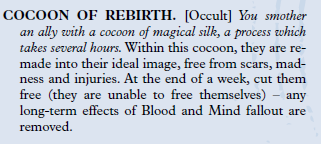
High Heal yourself of all Blood stress and fallout. Suppress and gain immunity to the magic of others. Take the form of a monstrous half-spider, half-drow.
Vermissian Sage
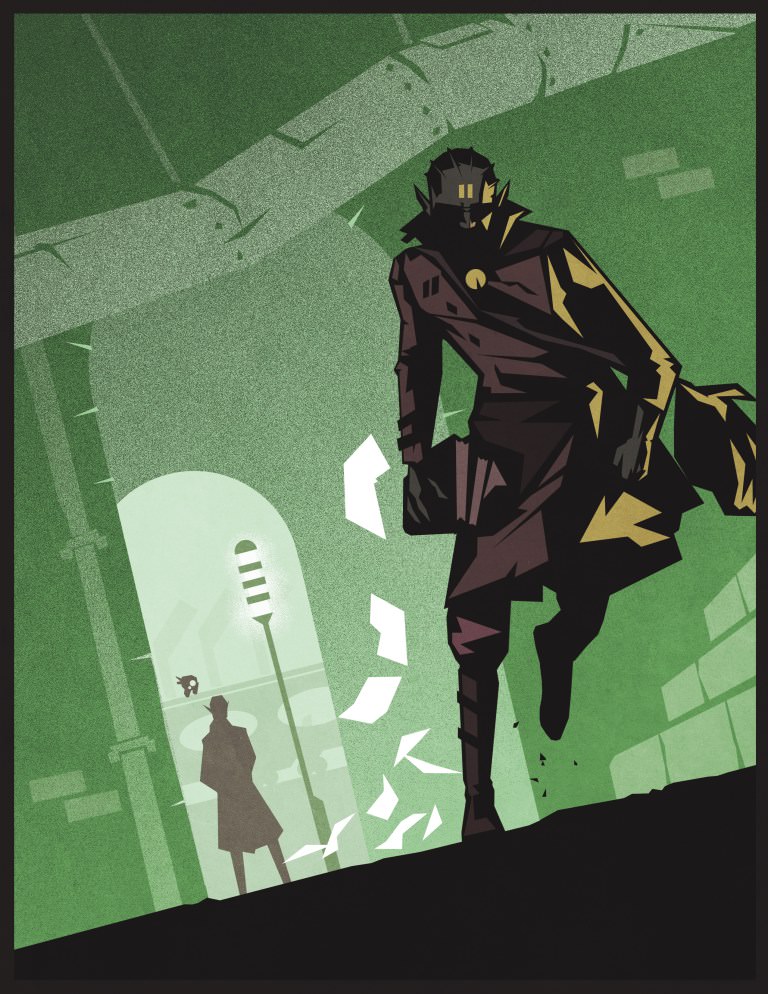
“I reckon I’ve got just the book you need – problem is it’s eight stations down and five across, so you might want to bring provisions.”
The Vermission was a grand failure; an attempt by human retro-engineers to create for Spire a mass transport network befitting its scale. Unfortunately many of the lines wound around the Heart itself - the bleeding wound in reality in the centre of the Spire - and buckled the walls between worlds. The Vermission Sages are a sect of rogue Drow historians, using abandoned stations and dead-end lines to store history and artifacts saved from the civil-war wracked Home Nations as their Vermission Vault.
They are scholars - great Mind resistance, with a tendency towards abusing the laws of physics, and access to a great wealth of forbidden knowledge. Whenever they uncover more hidden information, they refresh stress.
Advances
Core When in the Vault, you can Investigate any subject you care to name. Each session, gain a Knack in any one skill or domain for the session.

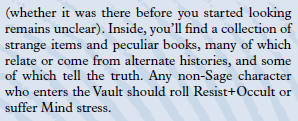
Low Declare two NPCs are connected in some way. Once per session uncover a hidden stash of equipment. File a fact or rumour in the Lost Stacks where it will fade from public memory. Punish people with pain for lying to you.
Medium Find out where in the Vault the answer to a given question lies. Prevent someone from speaking about a concept of your choice. Wipe the memory of a recent event. Drop someone through a trapdoor into the Vermission that might not have been there before.
High Prevent someone from understanding or percieving a concept of your choice (light is pretty effective for one). Rewrite history, removing fallout from you and your allies by doctoring newspapers and witness statements.
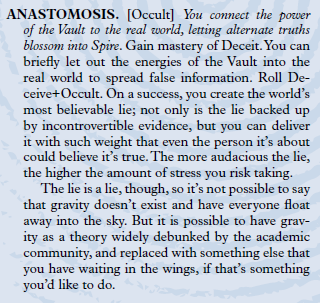
And our special guest, from the Black Magic supplement...
Blood Witch
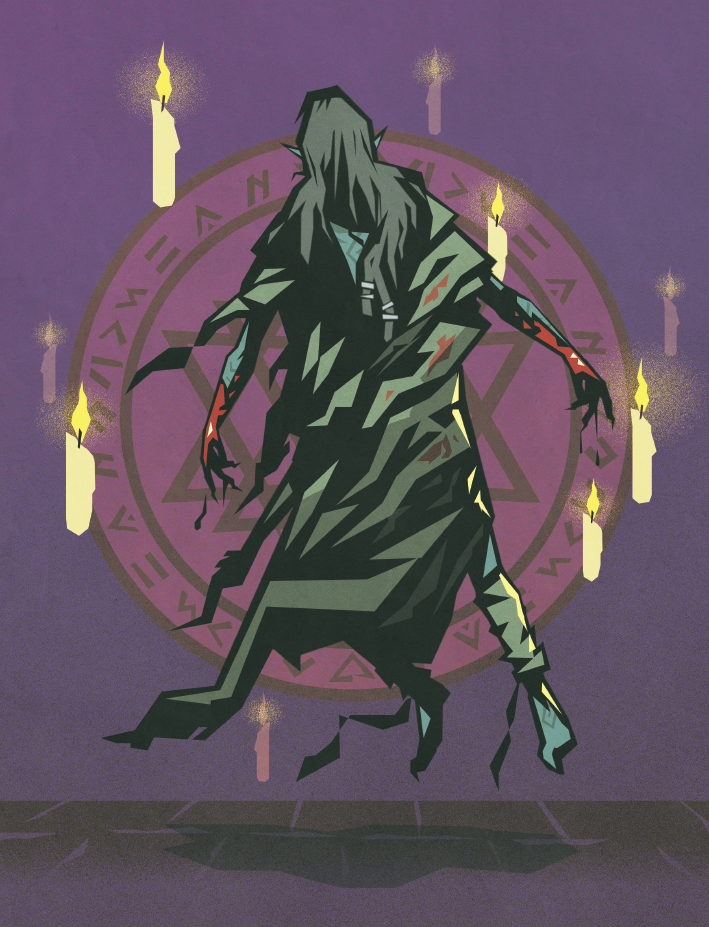
“I can hear your heartbeat, aelfir, and I hear terror.”
Sometimes, an over-ambitious magician journeys to the Heart of Spire. Sometimes they come back. Sometimes they come back... different. Blood-witchery is a disease which kills most men who contract it (and quite a few of the women), and lets the survivors channel the energy of the Heart itself.
Obviously, they have very good Blood resistance, and refresh stress, interestingly, whenever they share a moment of intimacy with another person. Of note; one of their Bonds is with a familiar creature which is under their control, warped by injesting their diseased blood. In play, they're full-on body horror - something out of
Advances
Core When you meet an NPC for the first time, declare that they crossed you and failed and are now terrified of you. Learn something of a creatures' past or future when you taste their blood.
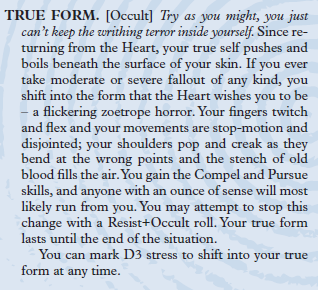
Low Grant more abilities to your familiar. Leave a ward that strikes out against your enemies. Exsanguinate your enemies with a word or curse them with three misfortunes.
Medium Your familiar becomes truely monstrous. Bond your allies with their blood, letting them switch places instantaneously (their bodies warp into each other). Introduce your blood to an NPC's body, mark stress to force them to perform a simple action until the next dawn.
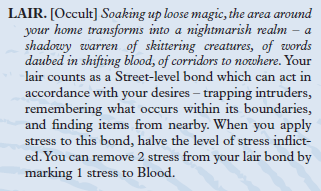
High Become unkillable, reforming in your lair or at the Heart. Concentrate to move your lair and recreate it around you. Plunge your consciousness into a target, posessing them completely.
Next: extra advance paths!
Part 8
Original SA post Spire part 7
Extra Advances
So, you have your class, and have access to the advances listed under it, plus you can take Advances from other classes - although you pay through the nose, so it's often not worth it. As well as these, you also have access to additional collections of Advances - similar to D&D prestige classes. Each path has a narrative requirement, usually requiring membership or experience in an organisation, a Refresh action which you gain when you take one of the advances, and the advances themselves.
So up until now I've been pretty much following along with the book in how I've ordered things. But alot of the extra advance paths make more sense side-by-side with the setting chunks they come from, so expect to see them a bit scattered through this review. But there's a few that are general enough, so I'll list them below. Most of them only have Low and Medium advances.
City Guard
Obviously, you have to have served in the city guard to take these advances. You Refresh whenever you make an arrest.
Low Subdue foes. Intimidate with the weight of the law behind you. Navigate bureaucracies.
Medium Select an NPC; the GM has to tell you what crimes they've committed. Work undercover, or become hardened against Mind fallout.
Enlisted
As with the guard, but you need to have served with the Allied Defense Force. Refresh when another character follows your orders.
Low Ignore minor fallout for a situation. Use your training as a squad leader. Carry a military rifle you hid away when you left the forces. Or maybe you recieved training as part of the Special Tactics Corps, opening your mind to the occult.
Medium Lead from the front. Keep people moving, no matter what. Your occult training extended to the implantation of a memetic virus, letting you be used as a ritual conduit.
Minister
A special case, as all the characters are assumed to be Ministers of Our Hidden Mistress; this is just going a little deeper, so any PC has automatic access. Once you have one of these advances, you also Refresh whenever you eliminate an enemy of the Ministry. One of the rare extra paths that have a High advance.
Low Take extra stress to avoid fallout. Bond your group so that everyone can hear each other, even out of earshot. Resist the sun's light. Extinguish lights in the area, and gain dark-sight.
Medium Make someone invisible to non-Ministers as long as they stand still. Create a warded prison. Create a perfect cover identity (based on someone you have tied up and gagged).
High Perform a rite on a captive, forcibly converting them to worship of Our Hidden Mistress, whether they want to or not.
Grangou
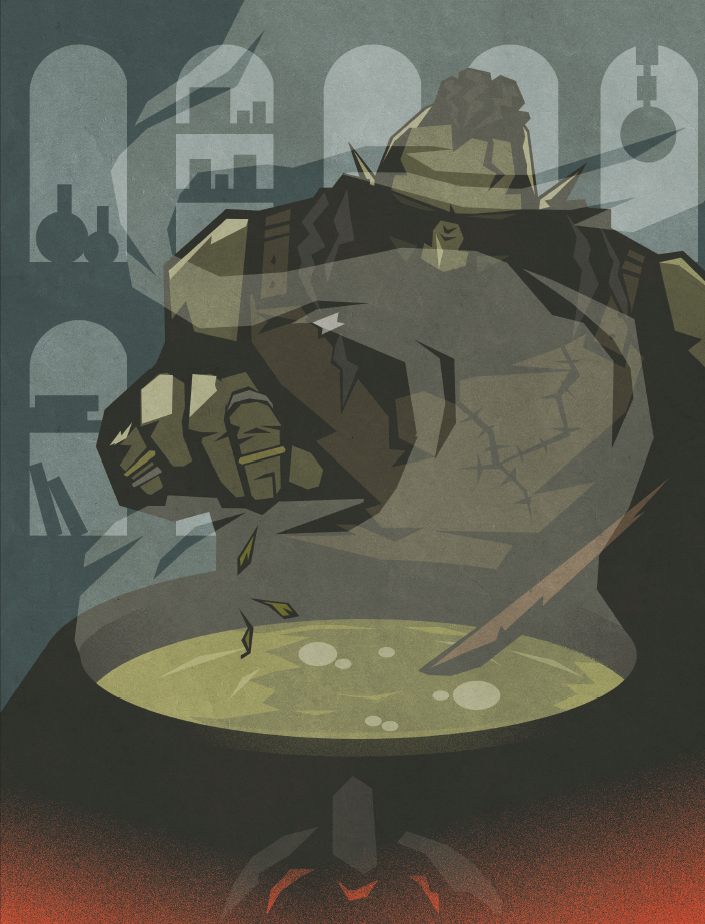
Another from the Black Magic supplement, and you could pretty much treat this one as a full class in its own right (although it doesn't have extra resistances, equipment or skills in its basic state). This is an old tradition, older than the worship of the Danmou, or the Solar Pantheon, based around passed-down hedge magic and traditional goat stew. Very much the heart of a community, they Refresh when they solve a problem in their community or prevent a situation getting out of hand.
Low Speak with the spirit of your community. Gain mastery in social checks when you share food or drink with someone. You no longer need to eat or drink. Curse a foe with crippling hunger. Your traditional goat stew now lends strength to those who eat it.
Medium Apply Mind or Blood stress to your community bond instead. Cast an illusion hiding negative elements of an area. Your goat stew strengthens even further.
High Place a corpse from your community into your cauldron, and make a soup to share with the other members. The corpse will return to life the next day. Fight with superhuman ability in defense of your community.
Next: Combat, such that it is, and an overview of the Spire itself
Part 9
Original SA post Spire part 9
Combat
In Spire, combat is just a situation like any other, and once again takes a cue from *World - it's treated as a conversation between the GM and players, rather than being broken down into turns and rounds - the most appropriate character is the one who goes next, and NPCs are purely reactive threats. That's not to say they don't act, but only in response to what the players do - if they have to close with the enemy, or spend time taking cover or reloading, then enemies will get closer or circle round them, causing stress.
Range is broken down into melee, ranged and extreme range, and is also simple; if you're out of range of an enemy, you take/cause a maximum of 1 stress on any roll. And that's it for the (page-ish) of combat rules. Before I dive into the setting itself, have a sample of what NPCs actually look like in Spire's rules;
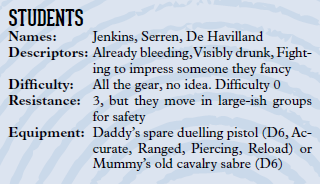
Pretty simple; Resistance is how much stress they can take before they're dead/fleeing/surrendering. Difficulty is how many dice you lose when acting against them, and their equipment generally gives an idea of how much stress they're going to cause the players.
Spire
Have a map. (KS backers got a high res version and it is glorious. EDIT: This will apparently be available from the Spire website at some point).
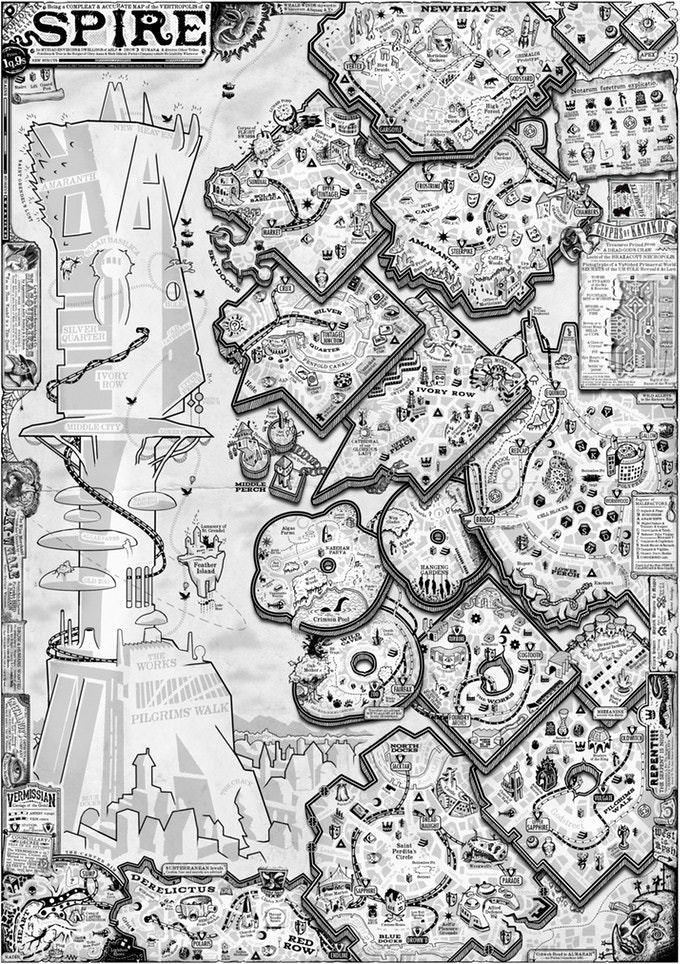
So generally, Spire is divided into rough tiers, with the upper classes sitting at the top, and the lower classes at the bottom. Underneath is the Underspire, with the Heart at its center. Normally it'd make sense to go top to bottom or vice versa, but the book arranges things by Domains, so I'll be following suit.
Next: Academia factions and locales
Part 10
Original SA post Spire part 10
So the setting part of the book - as mentioned - is broken down by Domain, and each chapter has a variety of smallish setting chunks, as well as an overview of a couple of areas of the Spire related to the Domain. I'll also be throwing in the extra advance paths where appropriate, as some of them - whilst pretty cool - don't often make a huge amount of sense away from the related part of the setting. Otherwise, things will proceed as the book does; largely alphabetically. Apologies in advance if I get quite terse - there's alot of stuff here and I'd rather just give an overview.
Districts and Factions of Academia
The Benevolent Order of Wisdom and Discovery
A collection of free schools, offering lessons in a wide and eclectic set of subjects to all and sundry, taught by enthusiastic volunteers. However;
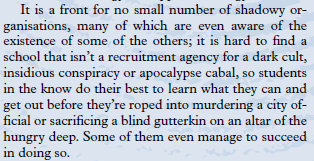
The Brotherhood of the Unlidded Eye. Demonology is throroughly forbidden throughout Aelfir lands, as it's a dangerous and unpredictable art, prone to exceptionally devestating consequences. This is an issue for the Brotherhood, as they're a multilayered cabal dedicated to the study of demons. Generally theoretical - they may be a shadowey and unknowable conspiracy, but they're not stupid, and it's a decent choice for the would-be black magician at the start of their career.
The Sisterhood of Illumination. An off-shoot of the church of Our Glorious Lady, dedicated to teaching and spreading information. Also a secret cabal of demonologists, due to their belief that to deem knowledge forbidden is sacriligeous. Currently at war with the Brotherhood.
The College of Undying Light. Funded by the Solar church, believing that all knowledge helps understanding of the gods. Also a bunch of lying, scheming demonologiests.
It's a possibility that all three organisations might just be a front for an ad-hoc Aelfir weapons program (the Aelfir use briefly-summoned demonic incursions as a weapon of mass destruction, albeit not officially).
More on Demonology when I go through the Black Magic supplement (in short: a bad idea, and the resulting dead are generally acclaimed to be the lucky ones).
Brazacott Technical Institute
Technical college, funded up-Spire for the advancement of knowledge in the fields of engineering, biology, sociology and information theory. Another front, albeit not for demonologists. The Institute is run by a group of academics who've had shards of a crystalline Prokakatos AI implanted in their brains, giving them access to a rudimentary hive mind - the best they can do given moden technology. They see themselves as 'Uplifted', and it must be said, not all volunteered for the procedure.
The High Elven University of Divine Magic
Every ancient, sprawling university campus anywhere. Classrooms and laboratories are stacked five or six stories high, connected by mazelike walkways and paths, with countless plazas, librares and staircases and very few accurate maps.
Built around its famous Infinite Library (not actually infinite, but built on the inner surface of a mobius strip), and its central Lunar Font, where moonlight is distilled into its liquid form (utterly profane to most drow), the University is also home to the infamous 'interview rooms'. These produce advances in medicine and technology, often based off the 'interviewing' of unwilling subjects; a process not many survive.
Also in a state of cold war, due to a prank played on the Aelfir Professor Westward-March-The-Faithful twenty-five years previously which frequently erupts into all-out conflict between gangs of inebriated students.
The Academy of Gywnn-Enforr
Human-run institute, linked to Brazacott, and hence also host to the Intelligence, but also those who aren't as willing to stab mysterious ancient rocks into their own brains in the pursuit of knowledge. Their Volatility Research department is a frequent source of galvanic devices and weaponry (and explosions) and their Tower Division seek to understand Spire itself, with Professor Arkwright's decade-long explorations into the Heart being the department's main source of income.
Next: Commerce!
Part 11
Original SA post Spire part 11
Districts and Factions of Commerce
Let's start off on a high point: (copied because I'd only end up writing it out verbatim).
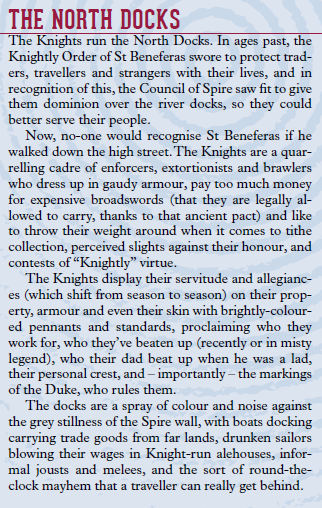
So yes, the North Docks are overseen by the Duke of the order of St Beneferas, who rules from their Castle - a decomissioned military paddle-steamer of human make. She (the current Duke being a female Drow called Westfall) exerts tenuous control over the feuding gangs of Knights, and is generally given free reign as long as the damage to the docks themselves is kept to a minimum.
The Range is a row of houses which have been completely knocked through, creating a jousting range. Of course, horses are rare in Spire, so this consists of drunkards running at each other full tilt.
The Sundered Bell is an Eidolon, an anchor-artifact that binds a demon into the real world. There were once seven such bells, which the ancient Drow used to summon the Kraken from the waters near the Spire, but only one remains, split into two on the orders of the Aelfir Warrior-Poet New-Rivers-Broken.
Solace. A home for the needy. Notable in that there appears to be no ulterior motive associated with it, and it may well be a genuine charitable institution.
The Heap A collection of half-sunk boats and rafts just outside of the docks. There's gnolls hiding out here amongst the outcasts and gutterkin, and they're probably up to something.
The Carmine Sceptre One of the toughest bars in the Docks, and home to the only order of Knights that's exclusively female. Also serves as a womans' shelter. Staffed almost entirely by middle-aged, impossibly violent woment and their equally violent children.
The Last Leg The only bar in the Docks who have never paid for their beer - and this is a matter of pride. Whenever the taps run dry, a small fleet heads out to plunder other inns or nearby trading vessels.
The Sky Docks
From the bottom of the Spire to the top. The sky docks generally serve a slightly higher class of trader. Giant delivery birds - including the infamous Spire megacorvidae - fly up and down the Spire itself, and carry goods to and from the great Skywhales that are the most common form of aerial transport to and from the city.
Megacorvidae aren't as smart as their smaller cousins, but are big enough to carry good and people up and down the city. Handlers are exclusively Drow and human - Aelfir don't get on with animals - and are generally a suspicious bunch.
Skywhales are enourmous floating creatures that slowly drift across the countryside, plucking bundles of the leaves from the trees below with their dozen or so trunk-like tentacles (and any creature foolish enough to sleep or be otherwise immobile in their path). Pretty slow and hard to steer, they're rigged with crude sails and other means of gentle persuasion.
The Instrumentalists believe that Spire is a massive, incomplete musical instrument whose songs will lead to enlightenment. There's currently a full seventeen different factions, all part of a nightmarishly complicated web of betrayals, alliances and counter-alliances, but all seem to have a knack for 'singing' to the city, unlocking doors and moving the very structure itself.
The Blue Port
The third commercial district of the Spire, opposite the Docks, the Blue port funnels incomers into the city through one of six gates (past a gauntlet of bribable guards and customs officials). The Bazaar at the centre of the Blue port is possibly the largest market in the known world. Pretty much anything can be bought or sold here, if you know where to look or know someone who knows.
The Low Wall Boarding House is basically a front for a network of smuggling tunnels through the city wall and throughout the lower levels of the city.
Mercenary Houses make their living either hiring out with the Allied Defense Force or being paid to keep trouble in the port to a minimum, but there's always a handful available if you need some short-term friends with a penchant for violence.
The Azurites are priests of Azur - dedicated to the god of commerces. They control much of the markets of the Bazaar, and are the reason the district is called the Blue Port - after the blue-and-gold of their sacred vestments.
Next: Crime!
Part 12
Original SA post Spire part 12Pretty much the half way mark now!

Districts and Factions of Crime
So Spire is barely-govenable at the best of times, but there's some parts of the city where the rule of law has just thrown up its hands in despair and gone home for an early night. Not just rough, poor and violent (that's covered under Lower Class), the Crime domain covers the gang masters, the drug lords and other organised crime.
Red Row
And at the heart of it all, is Red Row. Sitting just under the surface, this is the tip of the Underspire, which extends - some say - as deep as the spire is tall. The guard do maintain a presence of sorts here, although they mostly try to stay out of the way of any real trouble. Three bosses run Red Row - Mother Moon, The Sisters and Mr Winter - and sooner of later anyone who works here works for one of them, willing or not.
The Arena is pretty much as you'd expect; a smorgasbord of unregulated bloodsport carried out amongst indentured or impoverished gladiators. Mother Moon runs the arena, and her harem enforce order her with a silken fist wrapped in razorwire.
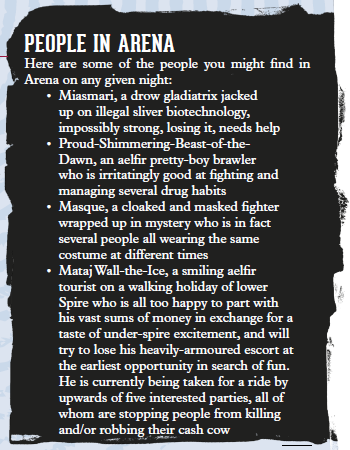
Brother Hellion's Church of the Gun is an oddity; a charismatic preacher of the sacred properties of gunpowder and the sanctity of bullets. It might be just a long-con, but his followers certainly seem to have unusual abilities when it comes to firearms.
Hellionite (extra advances)
Available to those who attend Brother Hellion's sermons, and who own a gun that they've named. Refresh when you use a gun to get what you want.
Low Bless a bullet to great effect or bind your fortune to a spun cylinder.
Medium Remove the need for powder and bulets, summon dark spirits into your weapon.
High Guns become destruction incarnate in your hands and bullets love you too much to cause you harm.
The Vorloren Standard is the only guard post in Red Row, staffed by washed-up losers, on-the-edge vigilantes and the occasional naive rookie who wants to clean up the undercity. Built into the premises of the defunct Vorloren Standard Warehouses and Shipping company they try to keep a low profile, cracking down on minor infractions whilst turning a blind eye to the bosses who rule the Row.
Threadneedle Square is the domain of the Sisters, rulers of the Underspire drug empire. There's three of them, and they're far removed from the business of actually dealing the drugs, relying on a legion of middle-managers, dealers and thugs.
Drugs in Spire
Drugs are widely available throughout the city, and their legality varies depending on where or who you are, often without regard to effect or potency. Here's a few from the list;
Malak is a mild depressent that's a daily tradition for most Drow; mild and non-addictive. Seventeen years ago, however, the Council outlawed its manufacture and distribution - pretty much to give the Guard an excuse to arrest or press into service any given Drow.
Godsmoke, made from dried fungus that grows near temples and churches. Gives a euphoric, pain-dulling high; popular with factory and farm workers.
Carotid. Grows from the walls in the deep parts of the city. Gives the impression that parts of the city's structure are alive; stone skin over metal bones. Might not actually be hallucinogenic.
Blues. Small pills that make the user feel impossibly sad. Generally used by Aelfir as most of them can't feel sadness naturally.
Sulphur. Pitch black crystals made from the run-off from demonic incursions. Massive rush which skews the morality of the user towards cruelty and unpleasant acts. Usually very expensive, but the availability of cheap Sulphur is a sign that someone in Spire's summoning demons. And that's not good for anyone.
Next: High Society
Part 13
Original SA post Spire part 13
Districts and Factions of High Society
This is the Spire, so High Society means Aelfir, and those who serve them. There's a few humans and drow who can claim to be part of this gathering, but it's mostly the high elves who are top of the social food chain. So we know they're magical, and cold, and cruel (or at least unfeeling when it comes to 'lesser' races), but there's another important factor, and that's their masks.
To go about unmasked in Aelfir society is an unforgivable breach of ettiquette, so all high elves and those servants who interact with them go about wearing a mask. In the case of servants, it's usually a mask representing their employer, marked with their role in the household. The Aelfir themselves have a multitude of masks - masks for dining, for sleeping, for hunting, for mourning; even masks to wear whilst choosing the mask for the day. They'll always also wear a true mask - unique to them - so that everyone knows who they are, and this will always be someone on their body, if not on their face.
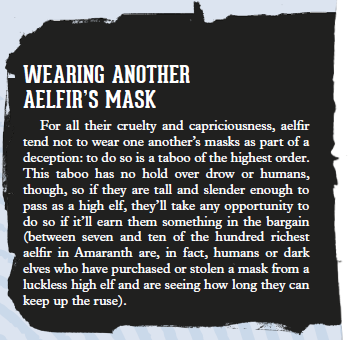
Amaranth
Inside the top tiers of Spire, Amaranth is where most of the Aelfir call home. It's beautiful, forbidding and extremely cold - whilst the high elves don't feel the chill, their staff tend to go about in heavy robes, gloves and scarves.
The Black Guard keep order in this district; the elite of the regular city guards, clad in blad armour and well-armed.
The Ice Caves are where the Aelfir go to slow down, to stop. Here they bath in icy water, slowing their heartbeats and chilling their blood. Oddly, this tends to improve their mood considerably, to the point where they almost seem capable of understanding the emotions of others, albeit as a certain remove. The reverse applies - Aelfir who spend time down-spire, or, gods forbid, on campaign in the deserts of the south tend to go a bit strange.
The Spiral Gardens epitomise the high elves, obsessed as they are with art. There's few plants or animals in these gardens that haven't been altered, tweaked or constructed entirely - the aelfir see their art as superior to that created by any god or natural force. Gnoll gardeners (the only gnolls the aelfir will tolerate) carefully tend poisonous bushes and shrubs - often Aelfir parties will include the introduction of an animal into the poison gardens, to succumb to the venom for the amusement of an audience.
Ivory Row
A hundred years back, when the drow still ruled themselves, Ivory Row was the place to see and be seen, the heart of society, founded upon the efforts of three ivory merchants, trading in unicorn-horn and tygre-tusk. Now the once-opulent mansions are falling into decay, still owned by a trio of landlords unwilling to give up any control.
The Sunlight Collective - group of bohemian occultists - follow the progression of twenty-six shifting windows as they make their way in great arcs around the outside wall of the spire. Being part of these groups is a bit of a rite of passage for down-and-out artists. Even the disgraced Warrior-Poet Petals-Cut-By-Rain spent time with the collective before launching her critically-acclaimed We, the Ten Thousand, Stand Waiting Eyes Wet Before The Sunrise (simultaneously a work of polyamourous elven love poetry and an invasion plan for the gnoll city of Al'Arjhama).
The Hidden are the squatters and vagrants who live in the abandoned mansions, dodging guards and watchmen and hiding away in ancient servants quarters and making markets in attics.
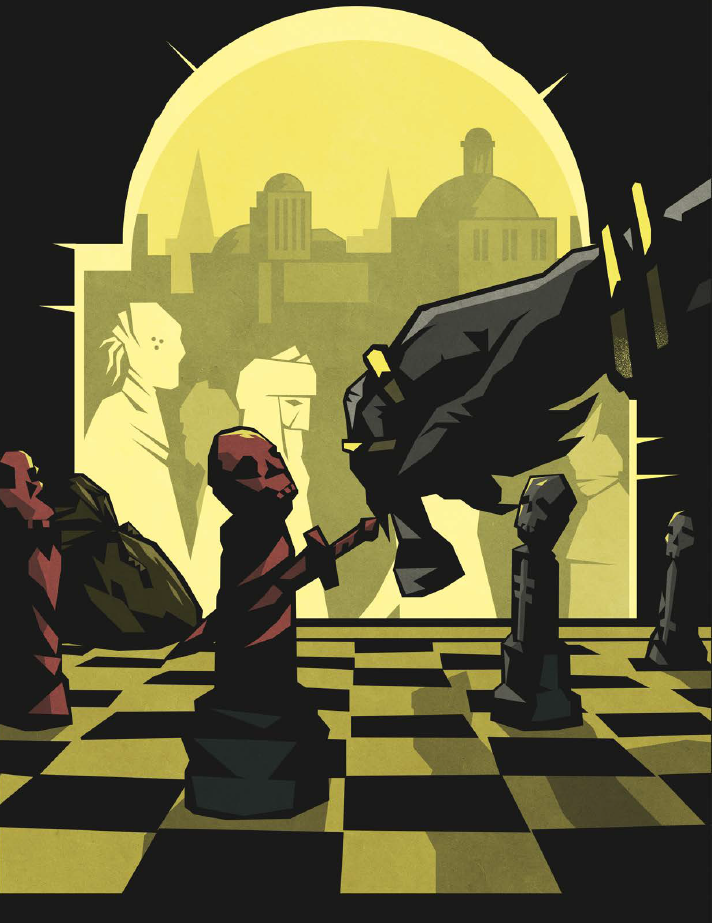
The Silver Quarter
The destination for the rich and famous from within Spire and without. A network of canals, supplied with water pumped up from the base of the Spire is home to roving gangs of boatmen and gondoliers, carrying the well-to-do between the many clubs and gambling dens of this district.
The House runs the Silver Quarter. Mesye So, the drow boss of this secret society / crime syndicate employs a staff nearly entirely consisting of disgraced Aelfir - his bodyguards are a cadre of ex-Skalds, the razor-wielding beserk battle-poets, and his messengers are the scions of a fallen high elf house whose founder took her mask off at court, dooming her entire house to a lifetime of shunning.
The Order of St Perdita runs lavish charity balls and galas, some of which even escapes the complicated system of money laundering schemes most of it gets tied up in.
The Gilded Oyster is devoted to the utmost in debauchery - sulphur benders, drunken brawls, even a room where Aelfir go about unmasked.
The Hearts are devotees of the luck goddess Stolz who run the Mermaid casino. Nobody steals from the Mermaid - the last person to do so stole a towel 'accidently' and was struck by lightning and incinerated on the way home. They're reckless and impulsive, as if luck's always on their side - and it often really is. They also perform traditional Stolzian marriages, in which lovers are attached to a special harness and flung off the side of the tower. If they survive (i.e. if the harness is attached to something), the union will be blessed.
Luck Priest of Stolz
Ordained after they've gambled an important part of their life in order to offer it up to Stolz, if she wants it. Must wear Stolz' sacred vestments - scarves and cloaks of many colours. They refresh when they risk their life or that of their allies.
Low Mark stress to re-roll any dice. Once a session find a gambling session with interesting stakes.
Medium Make the GM re-roll fallout rolls. Avoid damage in combat through sheer chance.
High;
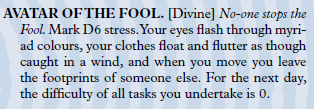
Next: Low Society
Part 14
Original SA post Spire part 14
Districts and Factions of Low Society - Part 1
Apologies for the delay, but now onto Low Society. These are the poorer areas of the Spire, and unlike the Criminal Domain, many of these districts are dangerous for what they are, not for who lives there.
Derelictus
Surrounding the subterranean tier which holds Red Row is a mess of broken and crumpled buildings, dead-end tunnels and oily sumps. This is Derelictus, where you live only if you can't make it further up-Spire. It's dark and dirty, a place of back-alley magic and knives in the back.
Hemlock Fruit Market
Illegal in the Spire, Corpsefruit is imported from the drow Home Nations and sold in Hemlock Market, along with other contraband - cave-squid ink, biomechanical sliver implants and more. The fruit itself is hallucinogenic, and it's claimed the visions are the dreams of the dead beneath the earth in which the fruit is grown.
Grist
In Grist, on the edge of Derelictus, they've found a new god; huge and bloated and always hungry, always well-fed. Becoming a ghoul is what happens when you eat flesh that thinks, and King Teeth has been a ghoul for a long long time - enough that he can grant some of his powers to his followers.
Faithful of King Teeth
All it takes is worship at his feet, and paying tribute to him with the flesh of man or elf or gnoll. And sharing his food of course. Refresh when you eat such meats.
Low Harden your nails, skittering up walls or swallow enemies whole to slowly digest them in your distended gut.
Medium Retch up acidic vomit that will eat through metal, flesh and stone.
The Church of Absolution
Worshippers of the Hungry Deep, entropy and rot incarnate. Exiled priests, madmen and burnt-out drug addicts gather at the feet of Mother Falling-Ash-On-Snow, whose touch blossoms mould and whose presence dims light.
Chosen of the Hungry Deep
Lose something irreplaceable to you, and prey to the Hungry Deep. Refresh when you destroy something of beauty (or someone).
Low Rot all food in a building or spawn a virulent disease. Rust or rot an inanimate object.
Medium Bless your allies, decaying the force of blows against them. Speak nightmares into a foe's ear or birth a swarm of horrid creatures into the world.
Perch
Perch isn't meant to be there. It hangs off the side of the Spire like a barnicle; an unplanned mess of ropes and tinder, sheltering under the Gutter - an ancient sewer outlet of tremendous size. This is a place of small gods - every citizen worships the spirits of everyday items; ropes, bridges, floors and doors. Indeed, the little gods of ropes are revered above all, as here it's your rope that;ll save you from tumbling to your death.
The Graveyard of Small Gods is where the possessions of the fallen are interred, as they still posses a spark of the divine spirit that lives within. Eventually, the priests will permit them to move on, usually to be sold back to the inhabitants of Perch.
The Bound are the justice in Perch - the guard won't risk themselves out here. They are police and judge for their community, levying fines, punishment, and in extreme cases the severing of the guilty party's rope-god (and the inevitable death by falling as a result). PC Bound are exceptional individuals, but there are many, many more out there.
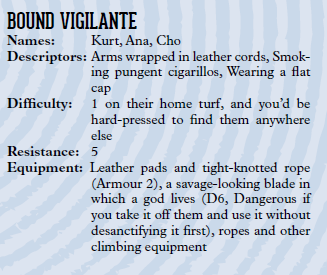
Next: More Low Society
Part 15
Original SA post Spire part 15
Districts and Factions of Low Society - Part 2
These places aren't just the homes of the poor, they're also where Spire is fed, and clothed, where ore is smelted and machines work endlessly.
The Gardens
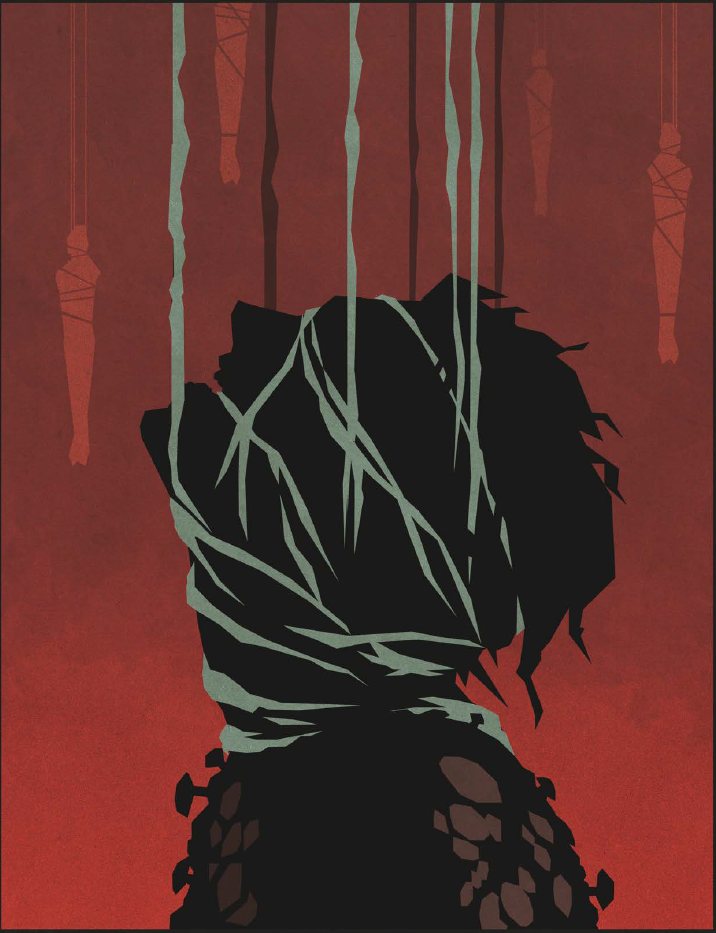
Due to the multi-layered nature of Spire, much of the area available for growing food is underground.
The Dark-farmers are traditional Drow farmers, tending huge copper vats of algae and raising swarms of locusts and grubs to be groundinto flour. And above all, the growing of mushrooms. If a family is too poor to provide a funeral for a loved one, the corpse is often sold to the Morticians guild, who will then sell them on to the farmers in the underspire. They're bound up in spider-silk and hung from the roofs of caverns where meaty, carnivorous fungi sprout from the bodies - an affordable source of protein.
The human-run Hydroponic Vaults use prokatakos technology to grow crops under artificial light, permitting the cultivation of vast subterranean fields of wheat and grain. These projects often run afoul of dark-farmer sabotage; they see the use of light as an affront to their traditions.
The Herald Corporation are a recent addition to the Spire; seeking to deliver food to the poor at a price they can afford. As usual this is a front - the head of the corporation is infected with a transdimensional sentient disease called the Vyskant and is trying to spread it through the Spire. Fortunately, it still can't infect without blood contact... (more on this later).
The Works
Counterpoint to the Gardens, the Works take up much of the lower levels of the Spire; a noisy reeking expanse of factories, warehouses and clanking machinery. Working here is a recipie for a short life of black-lung and crushing machines. The substance known as spireblack congeals on the walls here and no-where else; a slightly-flammable soot that when refined can be used as an explosive, as gunpowder, or as a source of cheap black ink, used to print salacious pamphlets and badly-spelled erotica which are consumed by the lower classes of the Spire.

The Machine Heart is a mostly-human cult of inventors and fringe scientists, who believe that the Spire is a broken prokatakos machine. They've cobbled together the titular Heart in an attempt to use it as a catalyst to restart the machine to its original purpose, whatever they believe it to be.
Greymanor Services is situated three flights of stairs above a printing press and is, all appearences to the contrary, the spire's foremost firm of private investigators. They're hirable for any paying job imaginable, and will happily freelance for a deserving, but penniless client.
Greymanor Investigator
Pass an interview with Maxwell Roche, head of Greymanor Services? You're now a hardbitten noir detective! Refresh when you solve a case the bureau assigns you to.
Low Lose a fight, ask the GM three questions about you investigation that connect to the fight. Make the GM tell you two ways an NPC is corrupt, one of which is true. Ask the GM what action would cause the most trouble.
Medium Ask the GM what an NPC's secret is - no hard evidence, but you've got a hunch. If you're drunk, take Reputation stress to ignore fallout.
High Ignore Blood stress that's less than half your current Blood stress - you can take a beating. Also;
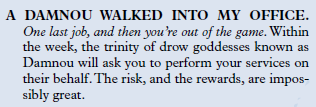
The Parliment of Gutterkin is a new thing. Slish is a runt of a thing - it looks like it's made op of at least one crow, but bent into human form - but it does have a certain charisma. It's gathering a band of dirty birdfolk, sump-goblins and other child-sized greasy humanoids into a crude parliment. A war is brewing now in the walls of the Works.
Next: The Occult (probably long)
Part 16
Original SA post Spire part 16Have started listening to the director's commentary and it's really very comprehensive - probably more so than my run through to be honest. Still, I'm most of the way through now. Grant also mentions that there'll be more setting splatbooks coming over the next few months.

Districts and Factions of the Occult - Part 1
Another long chapter this one, as the presence of the Occult in Spire is strong. Which is probably only to be expected given that it's a miles-high vertical city of unknown provenance.
The Vermissian
Had it been successful, the Vermissian would have been a wonder of modern engineering - a mass transit system linking every part of the Spire. Unfortunately, the combination of over-ambitious human engineering, corner-cutting on the art of the work crews and the fact that they were boring a network through a wierd, occult structure mean that things went a bit wrong. The energies of the Heart now spread through the tunnels, reaching throughout the city.
Polaris Station would have been the crown jewel of the Vermission, but it's now a vast black market - and notably, one where the Azurite priests are barred from entry (on pain of being nailed to the station clock).
The Last Train is said to still run on the rails of the Vermissian, its car and engine now an altar with which those who ride it bargain with, and sometimes steer it.
The Shrine to Our Lady of Vengeance in the ruins of a deep station is the one true temple of Lekole - last of the three Danmou, whose worship has been driven deep, deep underground. Her worshipers, the Crimson Vigil, or Vigilities are bunch of violent anarchists and terrorists, who even the Ministry is loath to have dealings with.
Vigilite
Join the Vigil. Destroy that which oppresses you. Refresh when you destroy someone or something important to your oppressors.
Low Start a fire with a word, adorn yourself with runes that are anathema to the Aelfir. Once per situation, choose an NPC. The GM will tell you what would make them angry.
Medium Inflict more stress when you're hurting. Heal (or harm yourself, it's a 50-50 chance) in flame.
High...
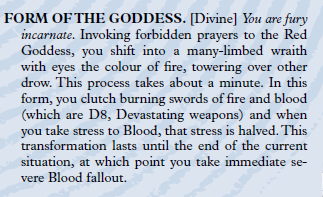
The Heart
There are those that claim the Spire is a creature, dead or alive, or living on geological time. Whether that's true or not, it has a Heart; an otherworldly pulsing infection deep in the core of the Spire which renders rational time and space a long lost memory. Blood witches have their origin here - the power of the heart manifest as an infection in the blood, and other, stranger things are caused by its proximety.
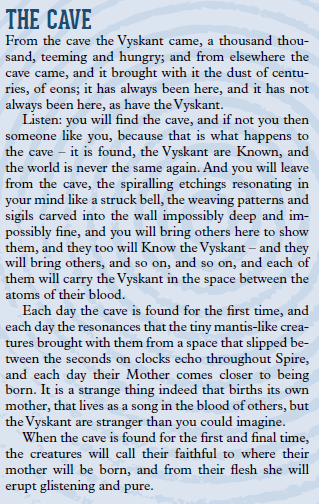
The Sightless Bees live in the Deep Hives in the Heart, blind builders who work ceaselessly at reinforcing the boundries of the world, against its malign influence. A sect of devoted apiarists guard their hives as they seek to bring a perfect order to otherworldly chaos.
Deep Apiarist
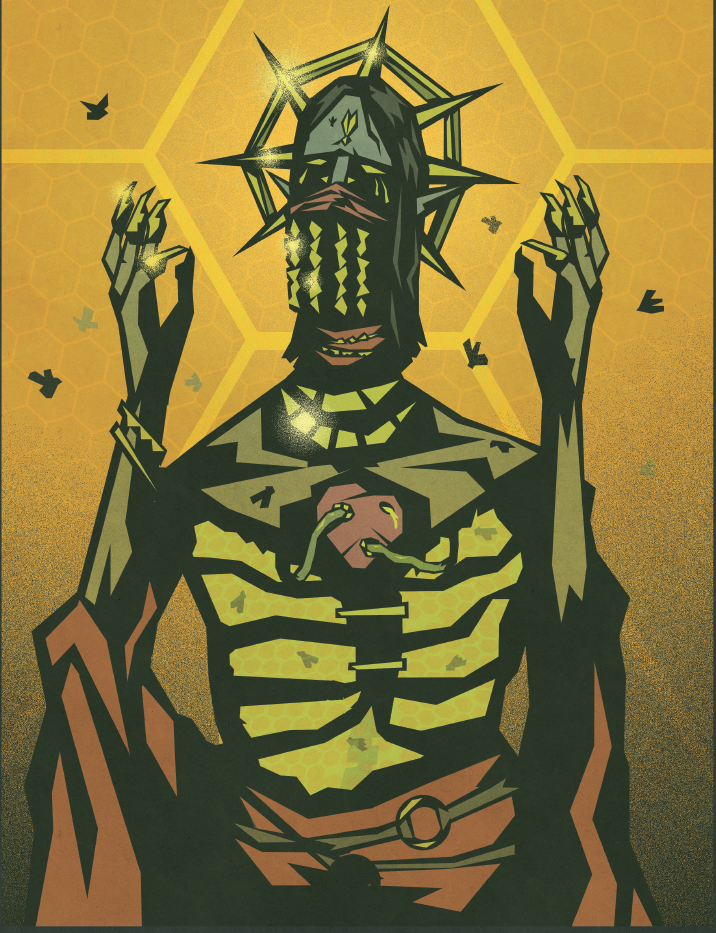
These are friends of the sightless hives; humans, drow and aelfir who attempt to maintain the wards that keep the Heart in check. To join them is simple - have some of your organs replaced with wax doubles, and become a living hive of bees. Refresh when you destroy an occult magician or an agent or artifact of the Heart. This is very close to being a full class in its own right actually - it only have one core ability (being a living hive of bees), and no resistance mods, but it has alot of advances.
Low Have the bees heal you slowly or release them to scare and confuse your enemies. Ask the GM about what chaotic things are about to occur near you and sense the power of the Heart (through jet-black compound eyes).

Medium Have your bees project a zone of stability, quelling occult magic. Have the queen grant you knowledge, or re-wind time to the point before your rolled - you were just extrapolating the results of your actions.
High Encase a creature in perfect crystal. Spread your mind out across all characters nearby, diving Mind stress across them.
Carter's Expiditionary Force came to the Spire when the humans first started to delve into ancient places. Excalibur Carter led his expedition into the heart of the Spire and haven't left since. They're decent guides if you want to get around spire - their minds aren't as good as they used to be, but they can't die, so there's that.
Vanishing Point is a street where perspective breaks down; all lines stretch parallel into the distance. If you walk down the street (staying in the middle, of course), you'll eventually end up in a warped mirror-Spire, grotesque and chaotic.
Next: More Occult!
Part 17
Original SA post Spire part 17
Districts and Factions of the Occult - Part 2
The rest of the occult factions are more concerned with life, and inevitably, death in Spire.
The Guild of Morticians
The Morticians, priests of Mehror, God of Snuffed Candles, also run what's probably the most successful business in Spire - that of burial and the afterlife. It's their job to dispose of corpses and in fact it's theoretically illegal for anyone else to do so in the city. Most of the time these are sold to the mushroom farms in the Gardens, but the wealthy pay for their bodies to be given to the birds of New Heaven, at the tip of the spire. The Aelfir, one and all are cremated.
The Undying are the creations of the Morticians - it's expensive and available usually only to Aelfir, but they have the art of replacing the heart of the living subject with a totemic item - as long as the heart is kept safe, the owner is frozen at the age at which the procedure is performed, and no longer ages. They don't need to eat, sleep or breath either, but they do go a bit odd over time. And you better trust whoever keeps hold of your heart...
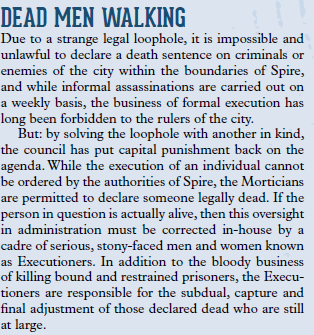
Ghost Plagues are what happens when bodies aren't dealt with, or a lot odd people die in a short space of time (or people are killed by alread-violent ghosts). When the concentration of the dead reach critical mass, they tend to form incorporeal conglomerates with massive psychic powers and violent tendencies.
The Necropolis
A vast vertical tunnel runs up through the center of Spire, from which run countless corridors and spiral stairs where the Morticians dispose of the bones of those who don't end up cremated or in the Gardens. To those with the Sight a bustling city of ghosts and spirits is revealed, however.
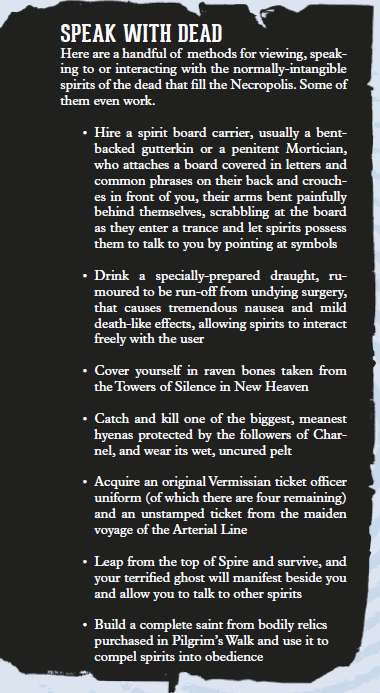
The Cult of Necrofusimancy believe that the Spire isn't a living creature, but the corpse of one, long since petrified and turned to stone. Furthermore, they believe that their necormantic arts can be used to divine and manipulate the city, like any other dead body.
The Grand Temple of Mehror is open to those who wish to pay their respect to the deceased, and tends to be quite busy during the day which drives the ghosts away. Money flows in from these pilgrims, as well as from the reselling of mortal remains (highly illegal actually), and donations from the Council (two of whom are undying). They also maintain the Library of Snuffed Candles, which holds the last of things - the only copies of cursed books, illustrated family trees of lost houses, and even the last known speakers of certain languages and dialects, kept in gilded cages.
The Midwives
Legend has it that the curse that makes the Drow so sensitive to the sun's rays also prevented them from carrying their young to term. The pact with Iskrah, the mother of spiders, means that thier children are now born as transluscent egg-sacs, two months after conception which must be fed blood for another six months until they emerge. Also, some drow get a bit spidery - extra eyes, mandibles, spinnerets and the like. The Midwives - priestesses of Iskrah - take these traits to even further extremes.
Next: Districts and Factions of Order
Part 18
Original SA post Spire part 18
Apologies for the delay, was getting perilously close to burning out on this much writing (for me, at least). But now on to...
Districts and Factions of Order
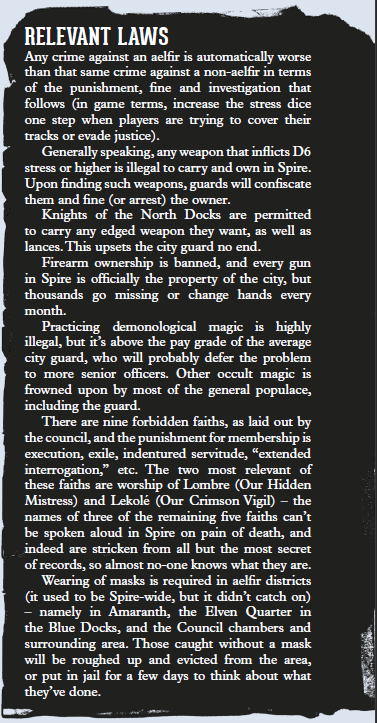
The City Guard
Underpaid, generally disliked and with the aelfir treating them like personal staff, it's a thankless job in the City Guard. Mostly Drow, and often local, they're in charge of enforcing an increasingly byzantine and convoluted collection of laws (which are the battleground of the divorced Aelfir couple who are responsible for codifying new law). Of course, the prohibitions on carrying a pig on Sunday in the North Docks or the requirement for every human in the city to craft five arrows a week, or the Spire-wide smoking bad are never actually enforced, but many of the minor regulations are often employed as an excuse to arrest any Drow the Guard want a word with.
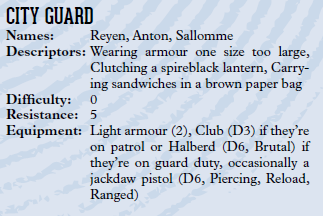
The Secret Police aren't an official organisation per se - just a bunch of smarter, or less jaded guards who are actually interested in solving crimes (or even predict future crimes) than just breaking up brawls and guarding their betters. It's pretty informal, just a gathering of watchmen around something distilled (or coffee on the night shift) who share information amongst themselves. Most will end up in a squalid garret with newspaper clippings connected by string on the walls, but some are actually quite good at this - and the Ministry often kill or suborn those who get close to them.
The Allied Defence HQ
Led by General Snow-on-Stone, the 'defence' force is the standing army, mostly Drow, who the Aelfir use in their wars with the gnolls to the south. Most of the enlisted are serving their Durance, although many of the veterans have signed on again, even past their enforced service. The general himself is an oddity amongst Aelfir warriors - he disdains the usual hign elven military tradition of combining leadership with artistic mastery, and instead has opted to travel, learning from the military leaders of distant lands. In fact, there's rumours he's not actually an elf himself - he's never seen outside of his full suit of platemail at least.
Skald Units are composed of inexperienced Aelfir who haven't attained the rank of Warrior-Poet. They leap into battle, waving an unpredictable mix of weapons, and often berserk or drugged into near-insensibility.
The Special Tactics Corps are, as far as the rank-and-file know, precisely that. Equipped with arcane and exotic weaponry, they are sent on missions that are both complex and incredibly dangerous. The truth is more disturbing - the corps are demonologists, practising an officially-banned art that nonetheless is the secret to the Aelfir's successes against the gnolls. Usually a drow agent will be implanted with a memetic virus - whispered into their ear by a Warrior-Poet when they're asleep - which turns them into an occult conduit. When triggered, a caster channels the summoning through the hapless agent, rupturing the skin between worlds. The result is usually very destructive, and equally disturbing.
The Council
Rule Spire. They number seven; one human, one drow and five Aelfir, two of whom are Undying and not lightly to step down any time soon, and are the final arbiters of all decisions in the city. When one dies or retires, the others vote on their successor. Of course, each one is looking out for their own social and business interests above that of the city itself, but they generally keep the city running in some semblence of order.
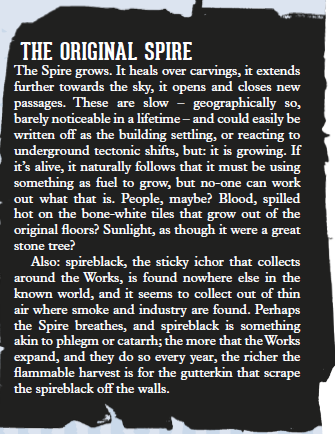
Next: Religion, and the last of the setting chapters
Part 19
Original SA post Spire part 19So, saw Grant Howitt at the UK Games Expo (and got lovely A3 posters of the high-res maps), and well, he's seen these posts which is a tad intimidating :-) Apparently you've all be buying loads of copies so that's cool. So now I feel pressured to buckle down and write the rest of these... (it's a pleasure, really) Anyway, with the talk of Mythender, isn't Religion and appropriate subject?

Districts and Factions of Religion
So onto one of the most interesting chapters in Spire - after all, religion drives a hell of a lot of the conflicts in the city, and the Drow themselves are traditionally quite a religious people, albeit with two-thirds of the Danmou forbidden under the Aelfir. One note is that Divine magic in the setting is pretty wizardly in nature - it's less provided by the gods, more shaped and made 'safe', as opposed to Occult magic which doesn't have those filters (and can make your brain come out through your ears pretty easily as a consequence).
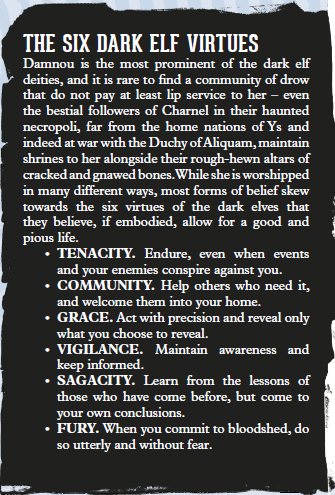
The six virtues can kind of be split between the three aspects - Our Glorious Lady, Limye, who embodies Tenacity and Community is still formally worshipped, and still sits at the heart of Drow life. Lombre, Our Hidden Mistress is who the Ministry worship, and her aspects are Grace and Sagacity. Lekole, Our Lady of Vengeance is followed only the the Crimson Vigil - now she's worshipped alone, her vengeance goes pretty much unchecked - as shown in the virtues of Vigilance and Fury. Enforcing the worship of only a third part of the triple goddess leaves much of dark elven society in a similar imbalance.
The Cathedral of Our Glorious Lady is the crumbling, rambling center of Drow worship. Lacking funds or supplies, and part-domitory, part soup-kitchen, part temple, the priests struggle to keep worship going, whilst tending to the poor and the destitute of drow society. Much of the upkeep is achieved through salvage and outright theft from other temples, building sites by teamps of enterprising priests and worshippers. This has caused something of a security arms-race with nearby builders' merchants.
The Ministry of Our Hidden Mistress
This is, of course, the organisation to which most players will belong. Worshipping Lombre; the dark side of the moon, and plotting to return the Spire to its rightful rulers. They see the church of Limye as cowards, if not heretical traitors, whilst the church see the Ministry as an organisation that does more harm than good. Of course, both agree that the Crimson Vigil are a bunch of violent lunatics who just want to see the world burn...
The Ministry itself follows a classic cell structure - each is overseen by a Magister; a senior figure in the cult, and often a retired Minister themselves - pretty much the only way to do so. Nobody really knows who run the whole thing, and rumours are rife as to who (if anyone) stands at the top, directing everything. At the other end, recruits are often spotted by a Magistrate (or occasionally volunteer themselves), and will be put through six challenges, each embodying one of the six Drow virtues. Once they pass those, the only way out is semi-retirement, or death - either at the hands of the Aelfir, or the Ministry themselves.
Pilgrim's Walk
Just inside the gates of the City proper, after passing through the docks, but below the Works is a place where gods and temples are stacked several layers high. It's a poor place, populated by pilgrims, beggers and priests, and it's pretty much in a state of constant low-grade warfare between priests and followers of countless minor deities. Some day the guard'll get the order to clear out the district, but until then it's knives in the allies, and chausibles and mitres at dawn.
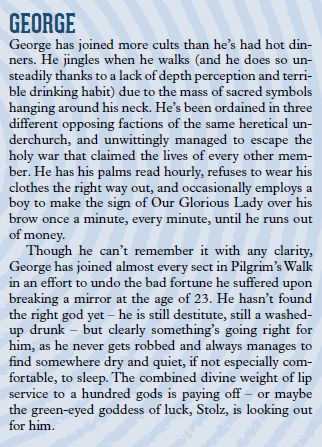
The Solar Basilica
In constrast the the crumbling glories of the Cathedral, the Solar Basilica is a glory in gold and white marble, where the Aelfir gods have been brought from their frozen homes in the far north to sit in state above the conquered city. Not just high elves worship here - the Solar Pantheon has followers amongst the humans and Drow as well.
Solar Devotee
Even a Minister might have some devotion to the Solar Pantheon, although it's rare, and will probably give them some grief down the line. Refresh by spending three hours in direct sunlight (although you don't have to have your skin exposed, which would be an issue for Drow).
Low Grant the Father's vigour, healing you and your allies or the Mother's blessing on their weaponry.
Medium Obtain the Brother's blessing, inflicting great stress in battle.
High Invoke the Sister's fire against your foes, or the Mother's curse upon machines.
The Pantheon themselves are Father Summer - growth, strength and health, Mother Winter - change, precision and mastery of the world, Sister Spring who grants fire, clarity, beauty and knowledge and Brother Autumn, also known as Brother Harvest or Scythe-Culls-the-Wheat in the Aelfir fashion. The actual Aelfir word they use to describe him could be translated as cruel, but in the High Elven sense, it's closer to "perfect". He's the god who knows nothing, but understands everything, and it's by his hand that all things die.
It's Brother Autumn who the Paladins follow. The gold-armoured, well equipped militant arm of the Solar Basilica. They're perfectly swift and merciless, devoted to their idea of justice and bitter, bitter enemy of the Ministry above all others. Fortunately, their degree of training means they're few in number.

Next: The GM section!
Part 20
Original SA post Spire part 20
Running the Game
I'll be a bit concise here as it's a bit more wordy (although they're very good words indeed).
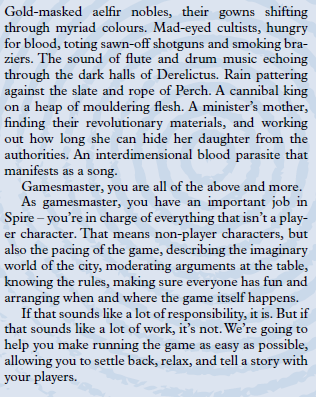
We kick off with a section on how to make the game fun, being open with the players about where their limits are and what kind of game they want to be playing. Fairly basic; you don't want to be making your players uncomfortable, and you want everyone to have a good time. Then we go striaght into some general GM advice;
The GM never rolls dice except for stress and fallout - purely reactively. The player's are the ones who get to roll.
But don't make the players roll unless they have to - the game is a conversation/story; only make rolls when there's something at stake.
Keep notes for consistency.
Say yes and fail forward - let the players push the game forward, and make failure a deviation, not a blocker.
Re-use before you invent - use old, established material in favour of bringing in new factions and characters.
Ask questions, and listen to the answers - keep the players engaged with the story.
Change stuff - don't be afraid to deviate from how the book tells things.
Now onto the theme and tone of Spire. General focus is on, obviously, revolution and sacrifice. This is a society which revolves around violence in dead end alleys, and religions worshipped in crumbling temples. It's not fair, it's not pretty, and those in charge see those below them as things; less people than tools or pawns. As ever, the GM can pick and choose just how far down each path they want to explore.
Magic - how common is magic in your game? Free and easy to access, or secret, rare and dangerous? How much control do the authorities have over practitioners, or are various orders and churches very much self-governed?
The Ministry - how wierd is it? Is is just a resistance network, or is it more cultish than that? After all, in the default setting the Ministers are properly ordained in the cult - does it get wierder the further up you go or is the ritual just another front?
The Villains - how evil are the Aelfir? Are they just normal people blinded by priviledge, or is their cruelty truely otherworldly? Or is the oppression of the drow done more out of tradition with younger Aelfir resistant to the inequality?
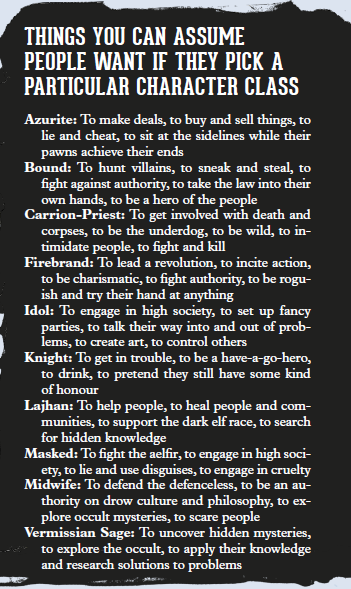
The Revolution
So the game breaks down the structure of each revolutionary act - each strike against the oppressors - into three acts.
The Gathering Storm is all about planning and gathering information, bribing informants and preparing blackmail material. This is intended very much to be player driven - they're picking the target and approach. The GM might have an over-arching plot in mind, and should dangle enough information for the players to go after without railroading them into it. The goal should be to change the status quo in some way, and this ties into the advancement system. Most sessions the players should be making the kind of small changes to the city to net them a Low Advance. Every three or four sessions, they should be hitting a bigger target - the fallout from that should be enough for a Medium advance. After a few such jobs, they should be aiming for the big time - High Advances require significant and lasting change to the city of Spire. This should give you an idea of tempo when it comes to planning.
The Strike is when it all goes down. This will be much more action-orientated, from a vicious assualt on a rival faction to an intricately-planned heist. The GM should make sure everyone plays a part - don't let just one player hog the lime light. Also, ask difficult questions and introduce complications - make them ask themselves what they're willing to do to win.
The Aftermath is where the players pick up the pieces, maybe try to take advantage of their success or failure. The GM should try to describe the effects on the neighbourhood, or on the players Bonds - make it feel consequential, with possibly wide-ranging ramifications.
The rest is then encounter design; balancing difficulty and writing a good villain. For the former, it's pretty easy - 0 is your run of the mill antagonists, a difficulty of 1 is harder than usual; complications or an NPC with skin in the game. Difficulty 2 makes most rolls pretty much a flip of a coin and should be reserved for really tought situations. For the latter, they reccommend a list of questions to ask about your villain; what they want and how they think they're going to get it, but also who they love and why, and what they're scared of. Villains should be as human (or drow, etc) as anyone else - not just one-dimensional sillouettes. Henchmen and lackies are then defined by how they differ from their boss.
Next time, appendices
Part 21
Original SA post Spire part 21
Well, it's close to the end of the main rulebook now. One of the nice things is that Spire is around 90% setting, if not more, and at least in my experience it's all been quite an interesting read. So now we get to the appendices - even more setting! Some of which originated in requests by higher-tier kickstarter backers.
Appendix 1: The New Gods
The aforementioned backer rewards; eight gods imported into Spire via Pilgrim's Row and New Heaven. Notably, most of them are human - not just worshipped by humans, but humans seem to ascend into godhood at an alarming rate in the setting, in contrast to Gnolls or Elves, whose gods tend to be more abstract.
Most of the New Gods are structured as (smallish) extra advance paths. And they're all quite fun.
Ishtuk, God of Personal Demons
In the deserts of the south, the Drow of the wandering Duchy of Aliquam have collected numerous gods and minor faiths, worshipped in addition to the Danmou, and some of them have made it to the Spire. Ishtukism is an old faith; he is the brother of Charnel, grey and tired-eyed who preaches self-denial and self-mastery; the chaining of your inner demons. This gets a bit literal with a touch of magic.
Join the cult by forswearing something you love at Ishtuk's altar. Refresh when you are tempted and refrain at a cost to yourself.
Low Smell the vice of an NPC.
Medium Cough up stress as noxious black tar or drive a target to follow their basest urges.
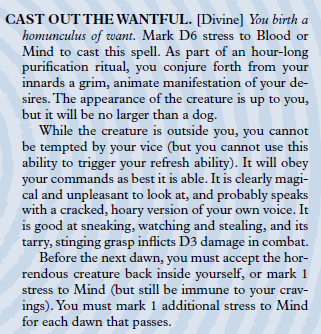
Luxulyan, the Duke of Air
The human god of (powered) flight. Once part of the cult (through a series of terrifying initiation ceremonies), followers of Luxulyan construct a Skyshrine (a medium advance) - a personal flying machine which works through a blending of technology and divine magic, and may be mechanical wings, a personal dirigible, jetpack, helicopter, you name it. Refresh by adding significant modifications to the shrine, which itself acts as a Bond, taking stress when you fly. Fallout is various flavours of it breaking down or crashing.
Apash, the Martyr of Whitecross
In his mortal life, the human known as Apash was instrumental in overthrowing the tyrannical despot of Whitecross; once the greatest of the arcologies unearthed by humanity. A hundred and fifty years later he's a popular cult figure, worshipped by increasing numbers of Drow in Spire. The cult's always open to new members of a revolutionary bent. Refresh by donating something useful or valuable to the cause.
Low Take a Firebrand low advance or mark stress to Blood or Mind when you'd otherwise take it to your other resistances.
Medium Deliver a sermon to prevent fallout to a bond.
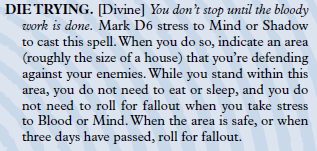
High The above, but in defense of a person, mission or idea.
Carabys, the Chained God
Not a god with a cult or worshippers, and evidence of the demonology the Aelfir deny using in their wars, Carabys was once a human mercenary. Implanted with an aelfir memetic summon circle, an attempt to use him to create a demonic incursion didn't cause the usual devestation to the world around, but instead was channeled into Carabys himself. Now he's something other than human, sustained by a cult of demonologist-priests who keep him chained in a hidden temple, mouth stapled shut to keep his powers bound, and fed on hidden truths. Petitioners can ask him for knowledge, but this always comes at a price.
The Many
From the Home Nations of Ys, embroiled in their never-ending civil wars comes a constant stream of refugees, bringing with them fragments of the old faith of the Drow; cthonic gods that never saw the sky. Here in Spire they've formed into a single religion, a faith of Drow tradition and family. Worshippers of the Many will take any genuine acolytes into their communion, although most are born to the faith. Followers refresh when they sacrifice for the good of their community.
Low Walk through wards of divine magic or gain knowledge and power from one of the aspect sof the many. Avoid stress when assisting another character.
Medium Ignore stress equal based on the size of your group.
[/i]High[/i] The Many unite to protect you from harm.
Miah, God of Secrets Lost
Faceless and gentle, Miah guards that which has been forgotten. Secrets are sacred to them, and their followers commit one of their own to the sacred flame. They refresh when they commit further valuable secrets to their god.
Low Burn a secret, avoid stress if it comes to light or gain a bond on someone who entrusts you with their secrets.
Medium Invoke a ritual to smooth over social misfortunes. After ten minutes of conversation with a (restrained) subject, become aware of the biggest secret they are harbouring.
High Condense the essence of a secret into a living being, preventing it from being spoken while the secret now lives. If they find this out, they take stress. If they speak their secret, they explode.
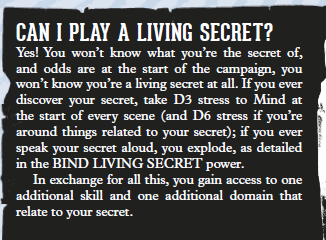
Garrick, the Steel-Boned
Another ascended human, Garrick was a skilled technician whose body was failing them, and who sought to patch themselves up with experimental prothesis. Eventually they were entirely machine and a cult has grown up of those who seek to emulate their idol. Worship of Garrick is open to any who are willing to implant or augment their bodies with technology. Refresh when you repair a machine that improves peoples' lives.
Low Replace your ribcage with silver and steel. Cut away a limb and splice on a mechanical replacement. Fix technology at a divinely augmented rate (and 'improve' it somewhat). Delegate simple tasks to a bundle of semi-autonomous machines.
Medium Gain mastery to Fight and Fix interacting with machines. Implanted galvanic coils can heal your body and mind (but weigh you down).
The Masked God
A recently-discovered being, as Drow have been forced to don masks in service to the Aelfir. Visions of the Masked god appear in the dreams or mirrors of the faithful, guiding their hand and giving them another face to show the world. They appear as a Drow in visions, but this is probably just another mask. To follow the Masked God, you much live the life of another person for at least a month, even when alone. You refresh when you successfully pose as another person.
Low Once a session, ask the GM who is lying. Change your face to that of anyone you've seen for the past day.
Medium Weave a blessing of anonymity and subterfuge. A minor lie you tell becomes true until the next dawn.
High Become a perfect replica of a subject you've met and studied. Once per session, ignore fallout entirely by having it happen to a cover identity.

And this is why the Masked God is probably the best of the bunch.
Next time; more appendices
Part 22
Original SA post Spire part 22
Last part of the main rulebook now; just the rest of the appendices and book/film/game/soundtrack recommendations to go. After that, there's the Black Magic sourcebook, at least those bits of it I haven't already talked about (Blood Witches, Graugachs, Deep Apiarists) which is basically the Occult source book.
Appendix 2: Random Items and Events
A whole bunch of d10 (and one inexplicable d12) tables to pull out for GM inspiration. Including;
- What does the Aelfir have in their pocket?
- Who’s this gutterkin, and what’s weird about them?
- What else does this experimental retroengineered tech do?
- What's strange about this tavern?
- What art is on display at this Aelfir's mansion?
- What is this plant and what does it do?
- What are they singing at church?
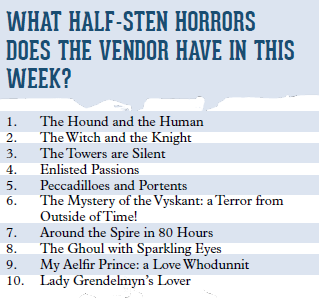
There's 17 in total, and whilst you'd probably have to do some of your own work, it's a pretty good base for setting tone and filling in random details.
Appendix 3: Drow Glossary
Basic list of Spire-drow slang; bits of Ys - spoken in the Home Nations, with some Aliqua (from the Duchy of Aliquam) and a load of Aelfir loan words. Nothing as cringeworthy as shadowrun or planescape at least. They mentioned something about the drow language in the audio commentaries; can't quite remember, but I'm pretty sure alot is based on an esperanto-esque conlang.

Appendix 4: Rumoured Goats of Spire
Another backer request. Nine species of goat, any of which may or may not be present in a given game. Includes the Yssian Dark - which don't mind living underground, the Latchkey Fiddler which can pick locks with their horns and tongues and the Supravertical Bok which likes to get as high up as possible, and have evolved to use tools and rudimentary levers. A bit more light-hearted than the rest of the book.
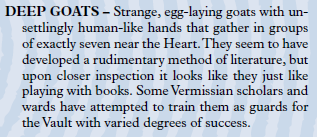
Appendix 5: Known Arcologies
Some of the human-settled Prokratakos archologies. Apparently the Prokratakos were originally just going to be dwarves until the writers decided it was a bit close to the Elder Scrolls for comfort. So they're now entirely mysterious, known only through technology recovered by human expeditions. These include the Blessed Isle of Whitecross - where early human explorers found the secret of gunpowder. It's now nearly abandoned as the best and the brightest have gone elsewhere. There's Deepest Brazacott, where the crystal hive-mind came from, and notably, Magwan Porth where the engines were found for the Vermissian. On the other hand, there's places like Damned Saltash, the contents of which were so horrible that Quintrel the Kind, known as the most sympathetic of the Wanderer-Kings had all mention stricken from the records. The arcology has been sealed off by a rock slide and is guarded by a sacred order of warriors who let none enter.
Appendix 6: Antagonists
More random tables to quickly come up with antagonists in a pinch. Two d100 tables here - one for City-level antagonists, and another for Street-level ones. The recommendation is to roll once on the former to find out the major plotters behind the scenes, then twice on the latter to get their lackies. Do it again, and you can build an entire campaign over two warring factions.
Appendix 7: Suggested Media
Last page of the book, not counting character sheet, index (and a good index at that) and backer names. Music recommendations include the Bloodborne and Only Lovers Left Alive soundtracks. Book suggestions include Perdido Street Station, Gormenghast, the Lies of Locke Lamora and Neuromancer. Films and TV include the urban theme - Dredd, Dark City, Hellboy 2, Peaky Blinders. Pretty short and sweet (and not just everything the authors played/read/watched whilst writing).
And that's it for Spire! Black Magic next.